
Home » Blog » Buy a boat » 5 best small sailboats for sailing around the world

5 best small sailboats for sailing around the world
By Author Fiona McGlynn
Posted on Last updated: April 19, 2023

A small sailboat can take you big places
Small sailboats are the ticket to going cruising NOW — not when you retire, save up enough money, or find the “perfect” bluewater cruising boat. In fact, it’s the first principle in Lin and Larry Pardey’s cruising philosophy: “Go small, go simple, go now.”
Small yachts can be affordable, simple, and seaworthy . However, you won’t see many of them in today’s cruising grounds. In three years and 13,000 nautical miles of bluewater cruising, I could count the number of under 30-foot sailboats I’ve seen on one hand (all of them were skippered by people in their 20s and 30s).
Today’s anchorages are full of 40, 50, and 60-foot-plus ocean sailboats, but that’s not to say you can’t sail the world in a small sailboat. Just look at Alessandro di Benedetto who in 2010 broke the record for the smallest boat to sail around the world non-stop in his 21-foot Mini 6.5 .
So long as you don’t mind forgoing a few comforts, you can sail around the world on a small budget .

What makes a good blue water sailboat
While you might not think a small sailboat is up to the task of going long distances, some of the best bluewater sailboats are under 40 feet.
However, if you’re thinking about buying a boat for offshore cruising, there are a few things to know about what makes a small boat offshore capable .
Smaller equals slower
Don’t expect to be sailing at high speeds in a pocket cruiser. Smaller displacement monohulls are always going to be slower than larger displacement monohulls (see the video below to learn why smaller boats are slower). Therefore a smaller cruiser is going to take longer on a given passage, making them more vulnerable to changes in weather.
A few feet can make a big difference over a week-long passage. On the last leg of our Pacific Ocean crossing, our 35-foot sailboat narrowly avoid a storm that our buddy boat, a 28-foot sailboat, couldn’t. Our friend was only a knot slower but it meant he had to heave to for a miserable three days.

Small but sturdy
If a pocket cruiser encounters bad weather, they will be less able to outrun or avoid it. For this reason, many of the blue water sailboats in this list are heavily built and designed to take a beating.
Yacht design has changed dramatically over the last 50 years. Today, new boats are designed to be light and fast. The small sailboats in our list are 30-plus year-old designs and were built in a time when weather forecasts were less accurate and harder to come by.
Back in the day, boat were constructed with thicker fiberglass hulls than you see in modern builds. Rigs, keels, rudders, hulls and decks – everything about these small cruising sailboats was designed to stand up to strong winds and big waves. Some of the boats in this post have skeg-hung rudders and most of them are full keel boats.
The pros and cons of pocket cruiser sailboats
Pocket cruiser sailboats present certain advantages and disadvantages.
More affordable
Their smaller size makes them affordable bluewater sailboats. You can often find great deals on pocket cruisers and sometimes you can even get them for free.
You’ll also save money on retrofits and repairs because small cruising sailboats need smaller boat parts (which cost a lot less) . For example, you can get away with smaller sails, ground tackle, winches, and lighter lines than on a bigger boat.
Moorage, haul-outs, and marine services are often billed by foot of boat length . A small sailboat makes traveling the world , far more affordable!
When something major breaks (like an engine) it will be less costly to repair or replace than it would be on a bigger boat.

Less time consuming
Smaller boats tend to have simpler systems which means you’ll spend less time fixing and paying to maintain those systems. For example, most small yachts don’t have showers, watermakers , hot water, and electric anchor windlasses.
On the flip side, you’ll spend more time collecting water (the low-tech way) . On a small sailboat, this means bucket baths, catching fresh water in your sails, and hand-bombing your anchor. Though less convenient, this simplicity can save you years of preparation and saving to go sailing.
Oh, and did I mention that you’ll become a complete water meiser? Conserving water aboard becomes pretty important when you have to blue-jug every drop of it from town back to your boat.
Easier to sail
Lastly, smaller boats can be physically easier to sail , just think of the difference between raising a sail on a 25-foot boat versus a 50-foot boat! You can more easily single-hand or short-hand a small sailboat. For that reason, some of the best solo blue water sailboats are quite petite.
As mentioned above small boats are slow boats and will arrive in port, sometimes days (and even weeks) behind their faster counterparts on long offshore crossings.
Consider this scenario: two boats crossed the Atlantic on a 4,000 nautical mile route. The small boat averaged four miles an hour, while the big boat averaged seven miles an hour. If both started at the same time, the small boat will have completed the crossing two weeks after the larger sailboat!
Less spacious
Living on a boat can be challenging — living on a small sailboat, even more so! Small cruising boats don’t provide much in the way of living space and creature comforts.
Not only will you have to downsize when you move onto a boat you’ll also have to get pretty creative when it comes to boat storage.
It also makes it more difficult to accommodate crew for long periods which means there are fewer people to share work and night shifts.
If you plan on sailing with your dog , it might put a small boat right out of the question (depending on the size of your four-legged crew member).

Less comfortable
It’s not just the living situation that is less comfortable, the sailing can be pretty uncomfortable too! Pocket cruisers tend to be a far less comfortable ride than larger boats as they are more easily tossed about in big ocean swell.
Here are our 5 favorite small blue water sailboats for sailing around the world
When we sailed across the Pacific these were some of the best small sailboats that we saw. Their owners loved them and we hope you will too!
The boats in this list are under 30 feet. If you’re looking for something slightly larger, you might want to check out our post on the best bluewater sailboats under 40 feet .
Note: Price ranges are based on SailboatListings.com and YachtWorld.com listings for Aug. 2018
Albin Vega 27($7-22K USD)

The Albin Vega has earned a reputation as a bluewater cruiser through adventurous sailors like Matt Rutherford, who in 2012 completed a 309-day solo nonstop circumnavigation of the Americas via Cape Horn and the Northwest Passage (see his story in the documentary Red Dot on the Ocean ).
- Hull Type: Long fin keel
- Hull Material: GRP (fibreglass)
- Length Overall:27′ 1″ / 8.25m
- Waterline Length:23′ 0″ / 7.01m
- Beam:8′ 1″ / 2.46m
- Draft:3′ 8″ / 1.12m
- Rig Type: Masthead sloop rig
- Displacement:5,070lb / 2,300kg
- Designer:Per Brohall
- Builder:Albin Marine AB (Swed.)
- Year First Built:1965
- Year Last Built:1979
- Number Built:3,450
Cape Dory 28 ($10-32K USD)

This small cruising sailboat is cute and classic as she is rugged and roomy. With at least one known circumnavigation and plenty of shorter bluewater voyages, the Cape Dory 28 has proven herself offshore capable.
- Hull Type: Full Keel
- Length Overall:28′ 09″ / 8.56m
- Waterline Length:22′ 50″ / 6.86m
- Beam:8’ 11” / 2.72m
- Draft:4’ 3” / 1.32m
- Rig Type:Masthead Sloop
- Displacement:9,300lb / 4,218kg
- Sail Area/Displacement Ratio:52
- Displacement/Length Ratio:49
- Designer: Carl Alberg
- Builder: Cape Dory Yachts (USA)
- Year First Built:1974
- Year Last Built:1988
- Number Built: 388
Dufour 29 ($7-23K)

As small bluewater sailboats go, the Dufour 29 is a lot of boat for your buck. We know of at least one that sailed across the Pacific last year. Designed as a cruiser racer she’s both fun to sail and adventure-ready. Like many Dufour sailboats from this era, she comes equipped with fiberglass molded wine bottle holders. Leave it to the French to think of everything!
- Hull Type: Fin with skeg-hung rudder
- Length Overall:29′ 4″ / 8.94m
- Waterline Length:25′ 1″ / 7.64m
- Beam:9′ 8″ / 2.95m
- Draft:5′ 3″ / 1.60m
- Displacement:7,250lb / 3,289kg
- Designer:Michael Dufour
- Builder:Dufour (France)
- Year First Built:1975
- Year Last Built:1984
Vancouver 28 ($15-34K)

A sensible small boat with a “go-anywhere” attitude, this pocket cruiser was designed with ocean sailors in mind. One of the best cruising sailboats under 40 feet, the Vancouver 28 is great sailing in a small package.
- Hull Type:Full keel with transom hung rudder
- Length Overall: 28′ 0″ / 8.53m
- Waterline Length:22’ 11” / 6.99m
- Beam:8’ 8” / 2.64m
- Draft:4’ 4” / 1.32m
- Rig Type: Cutter rig
- Displacement:8,960lb / 4,064 kg
- Designer: Robert B Harris
- Builder: Pheon Yachts Ltd. /Northshore Yachts Ltd.
- Year First Built:1986
- Last Year Built: 2007
- Number Built: 67
Westsail 28 ($30-35K)

Described in the 1975 marketing as “a hearty little cruiser”, the Westsail 28 was designed for those who were ready to embrace the cruising life. Perfect for a solo sailor or a cozy cruising couple!
- Hull Type: Full keel with transom hung rudder
- Hull Material:GRP (fibreglass)
- Length Overall:28′ 3” / 8.61m
- Waterline Length:23’ 6” / 7.16m
- Beam:9’ 7” / 2.92m
- Displacement:13,500lb / 6,124kg
- Designer: Herb David
- Builder: Westsail Corp. (USA)
- Number Built:78
Feeling inspired? Check out the “go small” philosophy of this 21-year-old who set sail in a CS 27.
Fiona McGlynn is an award-winning boating writer who created Waterborne as a place to learn about living aboard and traveling the world by sailboat. She has written for boating magazines including BoatUS, SAIL, Cruising World, and Good Old Boat. She’s also a contributing editor at Good Old Boat and BoatUS Magazine. In 2017, Fiona and her husband completed a 3-year, 13,000-mile voyage from Vancouver to Mexico to Australia on their 35-foot sailboat.
Saturday 1st of September 2018
Very useful list, but incomplete - as it would necessarily be, considering the number of seaworthy smaller boats that are around.
In particular, you missed/omitted the Westerly "Centaur" and its follow-on model, the "Griffon". 26 feet LOA, bilge-keelers, weighing something over 6000 pounds, usually fitted with a diesel inboard.
OK, these are British designs, and not that common in the US, but still they do exist, they're built like tanks, and it's rumored that at least one Centaur has circumnavigated.
Friday 31st of August 2018
This is a helpful list, thank you. I don't think most people would consider a 28' boat a pocket cruiser, though!
Terms and Conditions - Privacy Policy
Great choice! Your favorites are temporarily saved for this session. Sign in to save them permanently, access them on any device, and receive relevant alerts.
- Sailboat Guide

- Collections
Twenty Small Sailboats to Take You Anywhere
John Vigor turns the spotlight on twenty seaworthy sailboats that are at home on the ocean in all weather. These are old fiberglass boats, mostly of traditional design and strong construction. All are small, from 20 feet to 32 feet overall, but all have crossed oceans, and all are cheap.
Choosing the right boat to take you across an ocean or around the world can be confusing and exasperating, particularly with a tight budget. Vigor sets out to remedy that in this book. He compares the designs and handling characteristics of 20 different boats whose secondhand market prices start at about $3,000. Interviews with experienced owners (featuring valuable tips about handling each boat in heavy weather) are interspersed with line drawings of hulls, sail plans, and accommodations. Vigor has unearthed the known weaknesses of each boat and explains how to deal with them. He rates their comparative seaworthiness, their speed, and the number of people they can carry in comfort. If you have ever dreamed the dream this book can help you turn it into reality.

International Folkboat

Pacific Seacraft 25

Albin Vega 27

Cape Dory 25D

Contessa 26

Morris 26 Frances

Catalina 27

Falmouth Cutter 22

Pacific Seacraft Dana 24

Pearson Triton

Contessa 32

Southern Cross 31

Bristol Channel Cutter

Nicholson 31

Allied Seawind

Westsail 32
Embed this page on your own website by copying and pasting this code.

- About Sailboat Guide
©2024 Sea Time Tech, LLC
This site is protected by reCAPTCHA and the Google Privacy Policy and Terms of Service apply.
- Skip to main content
- Skip to secondary menu
- Skip to primary sidebar
- Skip to footer
Crowsurvival
Experience the Best that RVs, RV Accessories, Campers, Boats, Hiking & Fishing has to offer.
12 Perfect Small Sailboats
Jonathan Holmes 5.0 Rated 5.0 out of 5 5.0 out of 5 stars (based on 40 reviews)
Last updated on December 31st, 2023
Easy to rig, simple to toe, compact, manageable, maintainable, and affordable, all the perfect small sailboats have one thing in common: they always provide an adventurous tour in the sea.
So, either you are looking for something light on the pocket or just an adventure enthusiast wanting some safe daytime ride, the perfect small sailboats are the sole good means to fulfill your call.
After all, honestly, everybody does not need large 30 ft sailboats for cruising. However, large boats offer a lot of features like bunks, refrigeration , entertainment, and electronics. But are these features necessary for just boating? Well, I guess not.
When cruising, you only require a boat, a sail, a rudder, and a mast. Thus, nothing can offer you the ultimate adventures of coastal cruising better than small sailboats. Small sailboats not only provide you a breezy feel in the water but also offer you the opportunity to sense every change in trim instantaneously.
Table of Contents
12Best Small Sailboats
The market has a wide variety of small sailboats that measure less than 20 ft in size. Moreover, they are quite hit products as they offer great fun in the water.
With this guide, you may equip yourself with all the necessary information about the top 12 small sailboats. My top picks are just perfect as they’re simple to sail, easy to rig, and time-tested. Thus, if you were looking for a listing of the perfect small sailboats, you’re certainly on the right post.
Keep scrolling to read on for the best small sailboat picks.
Hunter 22 is a clever boat for a very fair price. It retains the hull of its predecessor- Hunter 216, featuring an open transom and a large cockpit. However, it is made of fiberglass with balsa-cored topsides and a solid bottom section.
Furthermore, the deck is a bit changed, having a 40 sq. ft. larger rig. Similar to Hunter 216, it, too, features a hydraulic ballast keel. The Hunter 22 is primarily designed to offer a thin line between “go-fast mini-sport boat” and “fun family daysailer and weekender”.
You can select between either half of them according to your requirements.
The cruising package features a simple electrical system, a portable toilet, and a V-berth in the small cuddy cabin. Whereas, the performance package offers an asymmetric spinnaker, a retractable bowsprit, mid-cockpit traveler, hiking grips, and straps in the cockpit.
- Hunter 22 is a daysailer.
- It offers a portable toilet.
- The manufacturers offer an optional electrical system with Hunter 22.
- The boat features a large cockpit and open transom.
- It offers a cuddy cabin and twin bunks.
- It features a hydraulic lifting centerboard and laminated fiberglass deck and hull.
- Comfortable
- Fair priced
- Easy for trailing
- Faster than most of the other boats available in the market
- Versatile and family-friendly
- Might need some replacement parts
Catalina 22 Sport
The retractable keel and basic amenities allow the Catalina 22 Sport to be trailered easily. Basically, the Catalina 22 Sport is an updated design of its predecessor Catalina 22.
The large cockpit is enough to seat a crowd. It offers a fractional rig with a mainsail and a roller-furling jib, a cabin that provides bedding for four with a forward hatch for ventilation, and a retractable lead keel.
In essence, the Catalina 22 Sport is more of a family-friendly racer. Also, it offers an alternative to choosing an older boat.
Besides, the Catalina 22 Sport offers the value and quality Catalina has come to expect since 1970. It is simple to rig and an excellent sail to step up from dinghy sailing to budget cruising.
- Catalina 22 Sport is a daysailer.
- It offers an adjustable outboard motor bracket.
- The boat features a comfortable cockpit with contoured coamings.
- It has an anodized aluminum mast and boom.
- It offers low stretch halyards and internal halyards.
- Catalina 22 offers a complete standing and running rigging.
- Many interior features, including Fiberglass Hull Liner, molded Headliner, and Low Glare Texture.
- Easy for trailing with its swing keel
- Family-friendly
- Simple to rig without a complicated setup
- Fast in speed
- Stability and reliability
- Features spacious cabin
- If you choose some old models, you will need some replacement parts.
- Not much trendy considering the interior and upholstery
Hobie Cat 16
The legendary Hobie Cat 16 has revolutionized boating . Firstly, it belongs to a proud watersports lineage, which within a few years of the foundation was loved by thousands.
Secondly, The Hobie Cat 16 is either used as a daysailer or a racer. The double banana-shaped hulls easily cut through the water, and the boat gets going fast even in light winds, as the aluminum alloy frame and two sails catch wind considerably.
Thirdly, there would certainly be no complete roundup of fun, trailerable, and small sailboats without any mention of the venerable Hobie Cat 16. The large trampoline provides a spacious platform to move about. Moreover, it offers many optional features, including a beach dolly, trailer, douse kit, a spinnaker, and a main and a jib.
In essence, it is a classic boat; enthusiasts and collectors covet it alike. Undoubtedly, it has the pedigree to prove that it is the red Ferrari in the world of cruising.
- The mast is 26 ft 6 inches tall and weighs about 320 pounds.
- The boat is 16 ft 7 inches in length and 7 ft 11 inches in width.
- Two color options are available.
- The dual-trapeze rig offers you harness its sheer power.
- The asymmetrical fiberglass hulls offer lift
- Low maintenance sailboat
- Reasonably priced
- Perfect for a Small Crew
- Easy to trailer
- Simple to rig
- Sailing may be hard when you’re alone.
Norseboat 21.5
In essence, the Norseboat 21.5 offers everything an expensive trailer-sailer does. It features a sensible centerboard arrangement, contemporary, good fit and finish, high-quality construction, and sea-kindly underbody.
The value of Norseboat 21.5 lies in its charm. You will easily fall under its spell if you are into the idea of a solid and easy-to-sail boat. The price tag looks much higher for a small 21 ft boat. However, the hype of Norseboat 21.5 tells you that it’s worth it.
Moreover, the NorseBoat 21.5 offers several configurations: one with a small cockpit and cabin that has a double berth for two adults and an optional berth for children, and another with an open cockpit and smaller doghouse.
Each of them comes with a ballasted stub keel and centerboard and carries the brand’s exclusive carbon fiber gaff-rigged mast. Also, the lightweight design of the Norseboat 21.5 offers easy rowing and a simple trailer.
- Norseboat 21.5 offers a lightweight design.
- It offers two different configuration options.
- Norseboat 21.5 has rowing stations.
- It features an electric outboard.
- The hull and deck are of fiberglass with a wood core.
- Comfortable and versatile
- Expensive compared to the other sailboats on the list
Barney Lehman and W.D. Schock designed the Lido 14. It is an American sailing dinghy that was built in 1958 for the very first time.
In essence, the Lido 14 is a classic sailboat that proves to be a perfect pick to suit small boats, especially for the owners who are still learning the ropes of boating.
The Lido 14 is just perfect for shorthanded racing, single-handed sailing, and solo sailing. It offers seating arrangements for about six people at most.
In the first year of its launch, two hundred Lido 14 boats were ordered. And, around 6300 Lido 14s had been built for 40 years. Today, a new Lido 14 boat is not available in the market; however, you will not regret ever getting a functional used boat.
Thus, the Lido 14 makes your investment worth it and serves you well throughout the journey.
- It offers a retractable centerboard raised with stainless steel straps.
- The hull features a near-vertical transom, a spooned plumb stem, and a transom-hung rudder controlled by a tiller.
- It has a fractional sloop rig with a loose-footed mainsail and anodized aluminum spars.
- Non-intimidating
- Has the car top capability
- Easy in handling
- New models not available
RS Sailing is primarily known for its line of racing dinghies. It built the 16-ft, 4-in sized Venture, which is such a perfect training and cruising dinghy.
The Venture offers a large, self-draining cockpit that can accommodate a group of friends or a family. Whether you are just messing about with your family or friends, club sailing, or just up for casual racing, RS Venture delivers the best with all its features. It is among the most versatile and nimble dinghies for sailing the masses.
In addition, the RS Venture can carry up to eight people in its self-draining cockpit. The excellent performance makes it adventurous; the multiple equipment options allow several boat configurations.
Moreover, the RS Venture is the winner of multiple awards. The excellent stability makes the boat ideal on coastal water, offering an advantage to those learning the sport.
More importantly, The RS Venture has the potential to carry more people in it than its dinghy rivals.
- The RS Venture offers a spacious platform.
- It features a rear back storage.
- The boat also offers reverse transmission.
- It has an open cockpit with high buoyancy.
- The exterior is composed of plastic and dual carbide.
- Can be car toped
- Versatile and stable
- Simple to handle
- Good looking
- A bit expensive
Super Snark
The Super Snark is a simple, lightweight, lateen-rigged daysailer, marketed as the “Super Sea Snark.” It is fun sailing, easy to learn, unsinkable, and simple to set up, and transport. Most of the people who get it find it satisfying to their sailing requirements.
Moreover, Super Snark is highly portable and storable. It can easily load onto your vehicle due to its construction and light-weight. In addition, the roof racks with slide-out loading bars make moving much easier.
Termed as unsinkable, the Super Snark is built with EPS foam, with the external hull and deck, which is vacuum-formed to the deep with ABS. polymers. The Super Snark weighs approximately 50 lbs having a capacity load of 310 lbs. It can carry two people at once.
- It has the capacity for two people.
- The internal hull leaves no void as it is filled with EPS foam, making the boat unsinkable.
- Mast, spar, and boom are of aluminum.
- It is made of recycled plastic.
- It weighs approximately 50 lbs
- Lightweight
- Car top-able
- Recyclable construction material
- Easy to learn
- Simple to setup
- Not family-friendly
The Laser is one of the most popular single-handed racing sailboats available in the market. With its simple rigging and simple design, Laser started single-handed racing 50 years ago when it came out. Interestingly, with over two lacs made, it is the most popular race boat in the world.
Everyone enjoys the Laser, from club racers to Olympians. It is a simple vessel to own and rig, which rewards practice and good sailing techniques. The Laser is built with updated foils and sail controls.
Moreover, a three rigs system allows the sailors to enjoy boating. It offers a seating capacity for two people. This boat is a fiberglass lightweight model easy for capsize and recovery.
- It has the capacity for two people seating.
- Includes the upgraded Vang, Cunningham, and Outhaul controls
- The boat features heavy fiberglass hull construction with aluminum spars.
- It has a small rudder with a lower boom.
- Worldwide popular and recognized racer
- Car top capability
- Stable and easy to handle
- A bit hard to sail
If you are looking for a good looking sailboat with excellent performance, the Paine 14 is here for you. It features a contemporary fin keel and spade rudder, which makes it more agile and faster.
In essence, Paine 14 is an old-time appeal with its varnished gunnels and transoms. However, it offers all the modern features every updated boat has. You can rig this boat with a gaff or a Marconi rig and can trailer it behind a vehicle.
In fact, Paine 14 can sail under mainsail alone due to the large flotation compartments fore and aft. The rig is simple, with an unstayed carbon-fiber mast and a mainsail bent onto its spars.
Overall, the Paine 14 feels like a favorite classic daysailer when you sit in it. The bronze hardware, the slatted-wood cockpit sole, and the varnished trim; all of these are elegantly designed. The cockpit ergonomics are seamless, and the sail controls fall perfectly to hand.
- It features a modern fin keel and spade rudder.
- The boat is built in seamless epoxy cold-molded wood construction.
- It has parallelly fitted fiberglass battens to the luff, which extend from the leech to the foot of the sail.
- Easy for trailing with its fin keel
- Good prevention of slippage
- Features spacious platform
- Not much trendy in looks
FAR EAST 18
The FarEast 18 is a low maintenance 19-ft vessel that offers high speed cruising in the sea.
Equipped with an open deck, the Far East 18 offers excellent performance. It offers great safety and stability due to its design. The hull has a beautiful shape that can be easily handled.
The lifting keel and the removable rig makes it easy to transport by a trailer. It takes a square-top fixed mainsail and an asymmetrical spinnaker, which is a driving force for buoy racing. The Far East 18 can compete with six crew but also offers bedding for three people when you are staying out overnight.
Moreover, this vessel features an updated bulb keel with carbon structure, vacuum-infused foils, and fiberglass hull. Best of all, a single person can easily rig and launch FarEast 18. Moreover, you can trailer this boat easily with a displacement below 1500 pounds.
All in all, Far East 18 is an excellent little sailboat available in the market.
- Small cabin instead of a reduced deck
- It features an updated bulb keel.
- The boat features a spacious cockpit.
- It has a lightweight structure.
- It is constructed with a vacuum infused polyester sandwich.
- Not too brutal on the pocket
- Comfortable and low maintenance
- Modest Price
- Does not perform well in strong wind
The Sage 17 was designed in 2009 by Jerry Montgomery. It is a small, stable, go-anywhere vessel, featuring a transom with a balsa core, a carbon fiber deck, and a cabin roof.
The Sage 17 is a 1300 pound vessel. It comes with a loose-footed main and a working jib that sheets inside the lifelines. There is a kick-up rudder, a 120-lb centerboard, and a 400-pound lead keel that will not strand while cruising through shallow water.
In addition, this boat is simple enough for beginners and sophisticated enough for experienced sailors. It is manufactured to handle your adventures with safety. It comes with a non-skid covering on the horizontal surfaces, a bow pulpit, transom-mounted boarding ladder, and a self-draining cockpit.
Moreover, this model is hand-built with vinyl ester resin, fiberglass, and carbon fiber in a lapstrake style to offer you enhanced strength. The cabin and deck are made of a balsa core and carbon fiber.
The Sage 17 sails fast in light air and provides unruffled travel as the wind blows more strongly. You will definitely enjoy hindrance free comfort in the airy open cabin. And, you can get customized cabin cushions that are available in different colors.
- Jib downhaul lead for the cockpit
- Cabin-top mounted winches and jib tracks
- Internal halyards
- Single reef main and working jib, with running rigging
- Complete mast and stainless-steel standing rigging
- Fiberglass and vinyl ester lapstrake hull with a carbon fiber
- Carbon fiber and vinyl ester deck with a balsa core
- A variety of options available to choose from
- Simple enough for beginners
- Safe and durable
- Quite reasonably priced, considering all the features
- Might require some replacement gears
Montgomery 17
The Montgomery 17 was designed for Montgomery Boats by Jerry Montgomery in conjunction with Lyle C. Hess. It was manufactured with centerboard and keel models.
The Montgomery 17 offers more stability than most of its rivals. And, when it comes to comfortability, the Montgomery 17 again stands above the rest.
This boat has the capability of going about moderate offshore passages. You can easily trailer it as it is small enough in size.
Moreover, it is designed with a masthead and toe rail that fits most of the foresails. It has a proper amount of storage area, a DC power, an optional shore, and seating arrangements for two people offering a headroom, a pair of bunks, and a portable toilet.
Overall, the Montgomery 17 is among the giant-killers of the market when it comes to performance. Though small in size, it makes its way past its larger rivals and excels in the extremes.
That is not just it; using a four-part gear, you can easily uplift the deck-stepped mast.
- The hull type is swing keel.
- A flush deck version is also available.
- Some versions feature a fixed keel.
- There are three types of keel configurations available; retractable keel, shallow draft fixed keel, and a shallow draft fixed keel in conjunction with a centerboard.
- Comfortability
- Quite faster than its rivals
- Outstanding racing record
- Favorable handicap
- Not suitable for deep sea
The Wrap Up
Hitting the water with the right sailboat can be an overwhelming task for many. To ease this process, the list above has narrowed down the 12 perfect small sailboats.
While there are infinite sailboats available in the market, the sailboats, as mentioned above, will serve you right and make you enjoy the ride.
However, in my opinion, the best of all is none other than the Catalina 22 Sport as it is the most moderate pick of all. You don’t have to compromise on either the quality or affordability.
In my opinion, you must not spend too little or much for too low or too high quality. A moderate model will serve as the perfect pick for you. Thus, Catalina 22 Sport being moderately robust and not-so-expensive wins my heart.
Related posts:
- Affiliate Disclosure
Our Love for this stuff, unfortunately, does not pay the bills. Our audience supports us. We may earn an affiliate commission when you purchase through links on our site. This does not mean your purchase price will be higher. Sometimes, it could be lower due to our relationship and volume with the merchant. So shop with confidence. You are getting a good deal!
Terms and Conditions - Privacy Policy
- BOAT OF THE YEAR
- Newsletters
- Sailboat Reviews
- Boating Safety
- Sailing Totem
- Charter Resources
- Destinations
- Galley Recipes
- Living Aboard
- Sails and Rigging
- Maintenance
- Best Marine Electronics & Technology

7 Small Sailboats for Everyday Cruising
- By Cruising World
- Updated: July 29, 2019
Not everyone needs a 30-foot sailboat equipped with bunks, a galley and head to go off cruising. In fact, all we really need is a hull, mast, rudder, and sail. There is nothing better than the thrill of a small sailboat or daysailer slipping through the waters of a lake, bay or even the open ocean.
Whether it’s simplicity to rig, ease of trailering or a manageable size that you’re looking for, these small sailboats are perfect for the cruising enthusiast who wants the thrill of the sea without the commitment of a 30-footer. And some of these sailboats come with cabins. This roundup of the best daysailers goes to show that sometimes big things come in small packages.
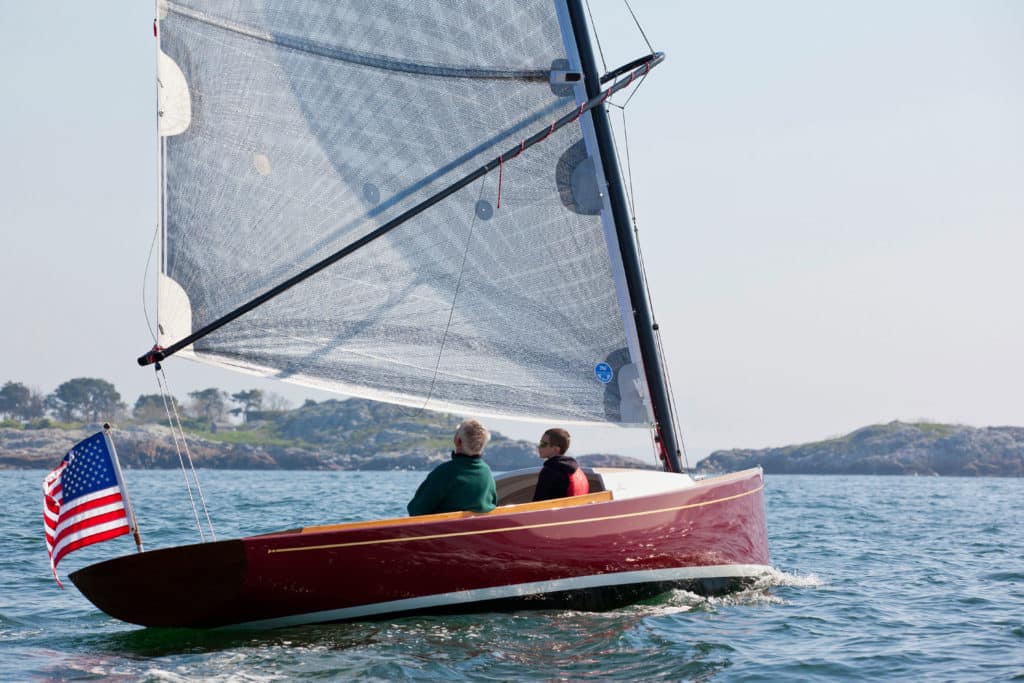
Marblehead 22 Daysailer
Traditional-looking above the waterline and modern beneath, the cold-molded hull sports a deep bulb keel and a Hall Spars carbon-fiber mast with a wishbone rig and square-top main. The 11-foot-9-inch cockpit can seat a crowd, and a small cuddy forward will let you stow your friends’ gear for the day.
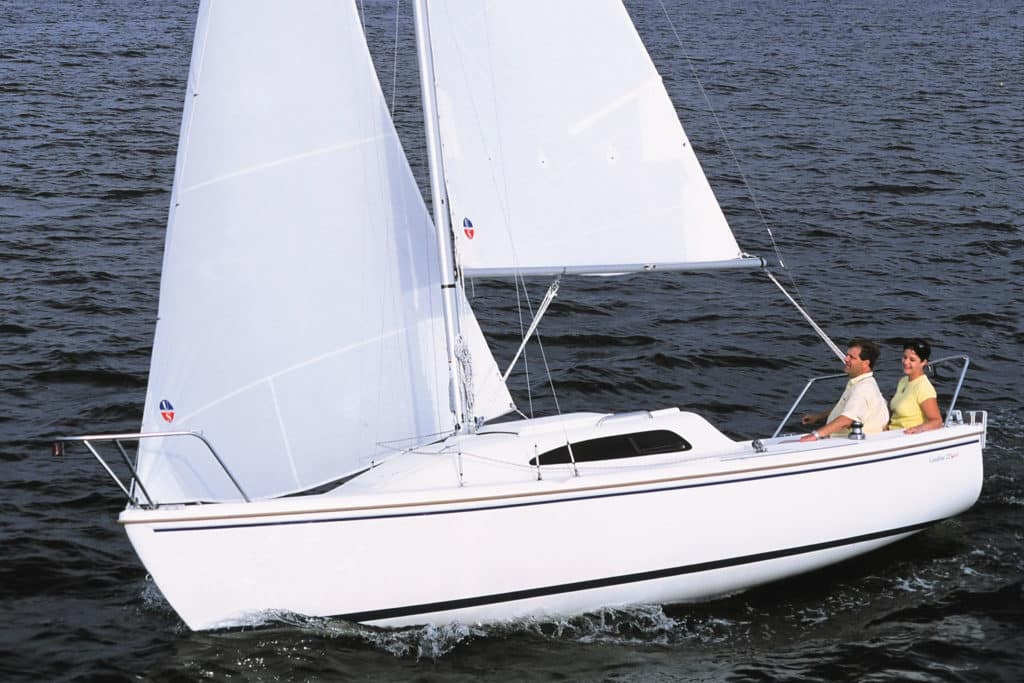
Catalina 22 Sport
Recently, the company introduced the Catalina 22 Sport, an updated design that can compete with the older 22s. The boat features a retractable lead keel; a cabin that can sleep four, with a forward hatch for ventilation; and a fractional rig with a mainsail and a roller-furling jib. Lifelines, a swim ladder, and an engine are options, as are cloth cushions; vinyl cushions are standard. The large cockpit will seat a crowd or let a mom-and-pop crew stretch out and enjoy their sail.
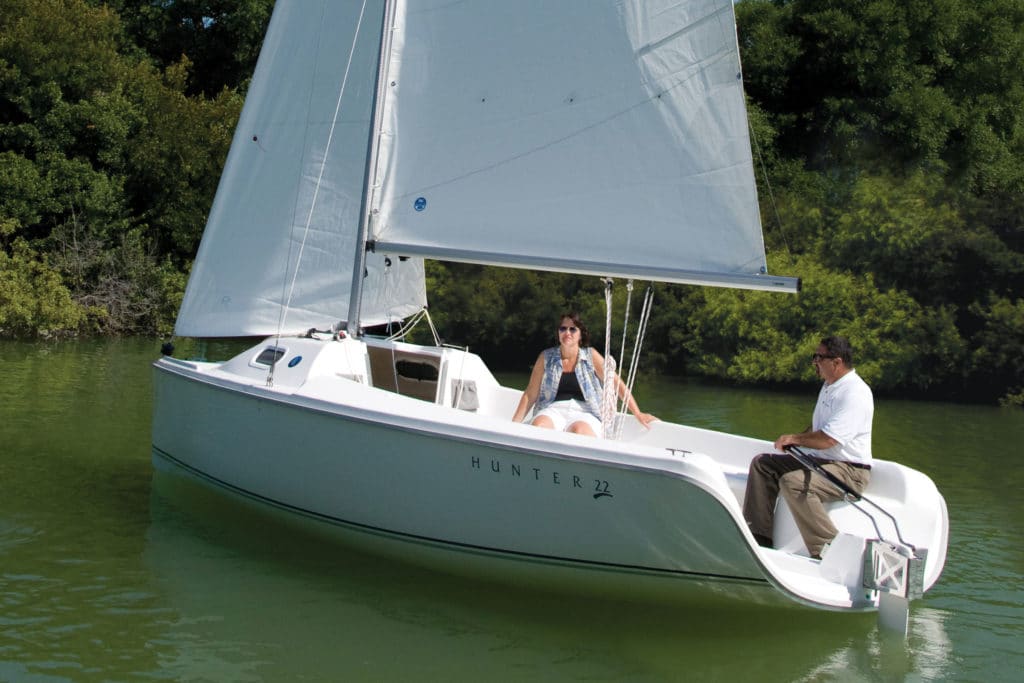
With its cuddy cabin, twin bunks, optional electrical system, opening screened ports, and portable toilet, a parent and child or a couple could comfortably slip away for an overnight or weekend. Add in the optional performance package, which includes an asymmetric spinnaker, a pole, and a mainsheet traveler, and you could be off to the races. The boat features a laminated fiberglass hull and deck, molded-in nonskid, and a hydraulic lifting centerboard. Mount a small outboard on the stern bracket, and you’re set to go.
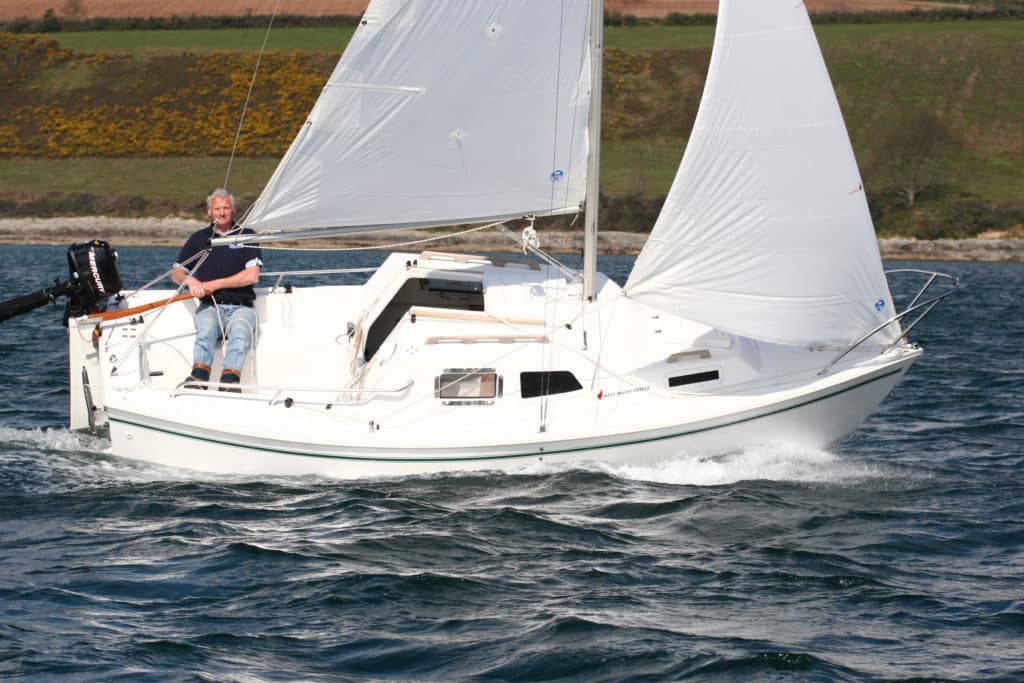
West Wight Potter P 19
First launched in 1971, this is a line of boats that’s attracted a true following among trailer-sailors. The P 19’s fully retractable keel means that you can pull up just about anywhere and go exploring. Closed-cell foam fore and aft makes the boat unsinkable, and thanks to its hard chine, the boat is reportedly quite stable under way.
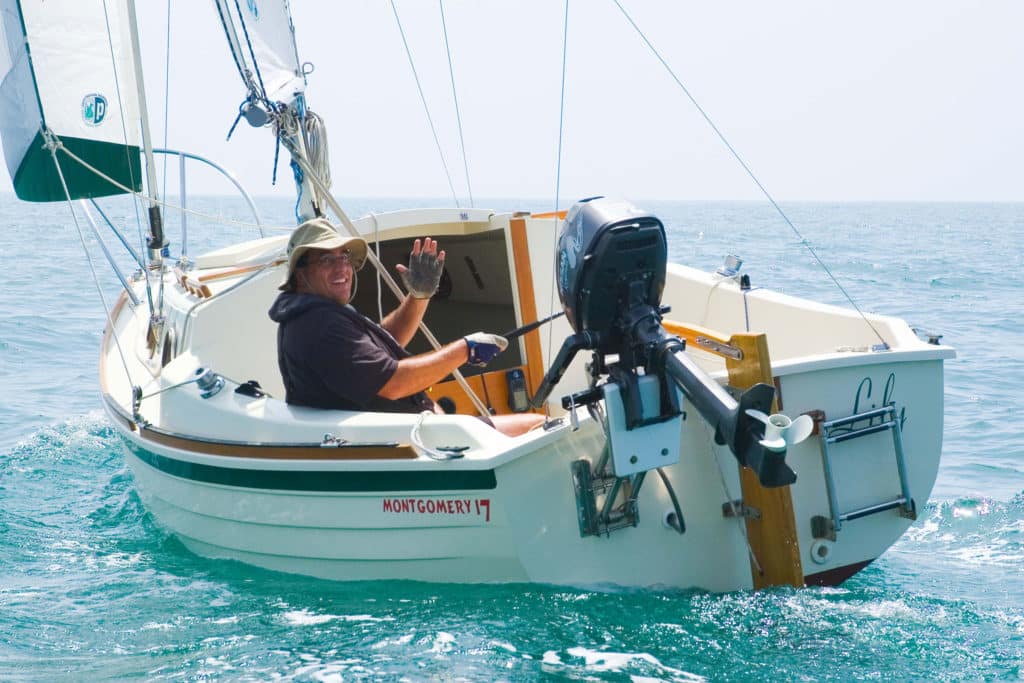
Montgomery 17
With a keel and centerboard, the boat draws just under 2 feet with the board up and can be easily beached when you’re gunkholing. In the cuddy cabin you’ll find sitting headroom, a pair of bunks, a portable toilet, optional shore and DC power, and an impressive amount of storage space. The deck-stepped mast can be easily raised using a four-part tackle. The builder reports taking his own boat on trips across the Golfo de California and on visits to California’s coastal islands. Montgomery makes 15-foot and 23-foot models, as well.
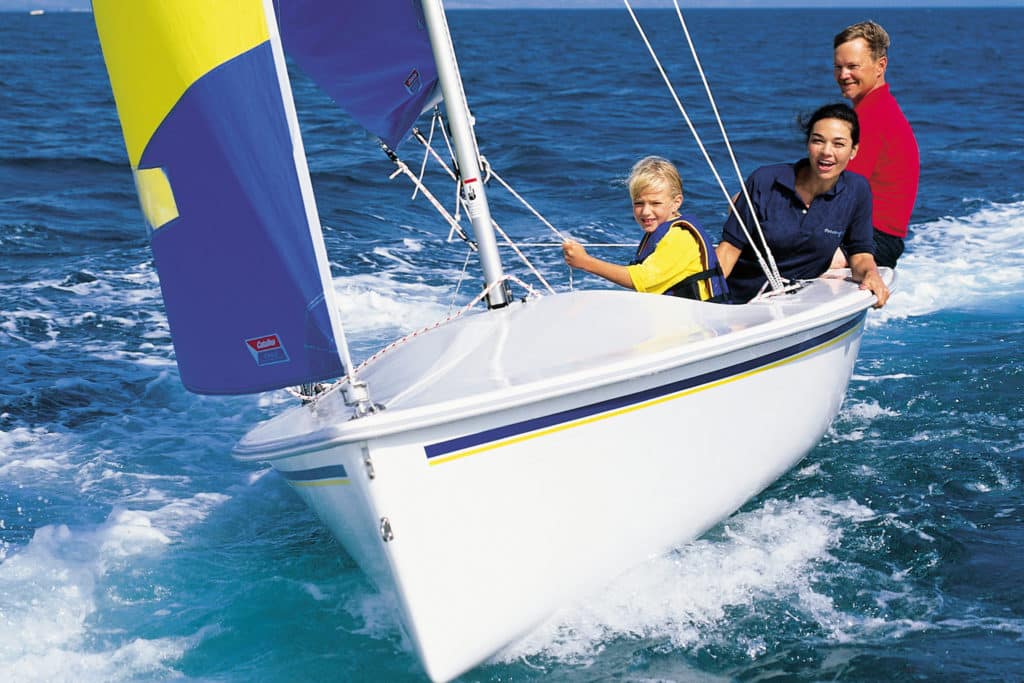
Catalina 16.5
With the fiberglass board up, the 17-foot-2-inch boat draws just 5 inches of water; with the board down, the 4-foot-5-inch draft suggests good windward performance. Hull and deck are hand-laminated fiberglass. The roomy cockpit is self-bailing, and the bow harbors a good-sized storage area with a waterproof hatch.
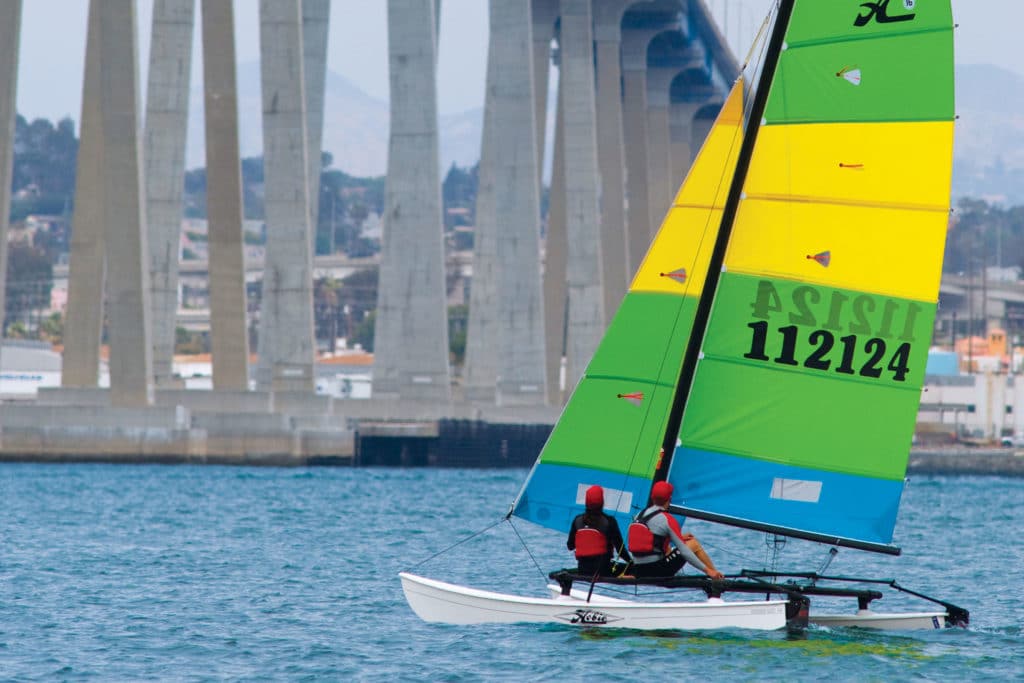
The company has introduced many other multihulls since, but more than 100,000 of the 16s have been launched, a remarkable figure. The Hobie’s asymmetric fiberglass-and-foam hulls eliminate the need for daggerboards, and with its kick-up rudders, the 16 can be sailed right up to the beach. Its large trampoline offers lots of space to move about or a good place to plant one’s feet when hanging off the double trapezes with a hull flying. The boat comes with a main and a jib; a spinnaker, douse kit, trailer, and beach dolly are optional features.
- More: 21 - 30 ft , Boat Gallery , monohull , Sailboat Reviews , Sailboats , under 20 ft , used boat guide
- More Sailboats

Sailboat Review: Tartan 455

Meet the Bali 5.8

Celebrating a Classic

New to the Fleet: Italia Yachts 12.98

Bitter End Expands Watersports Program
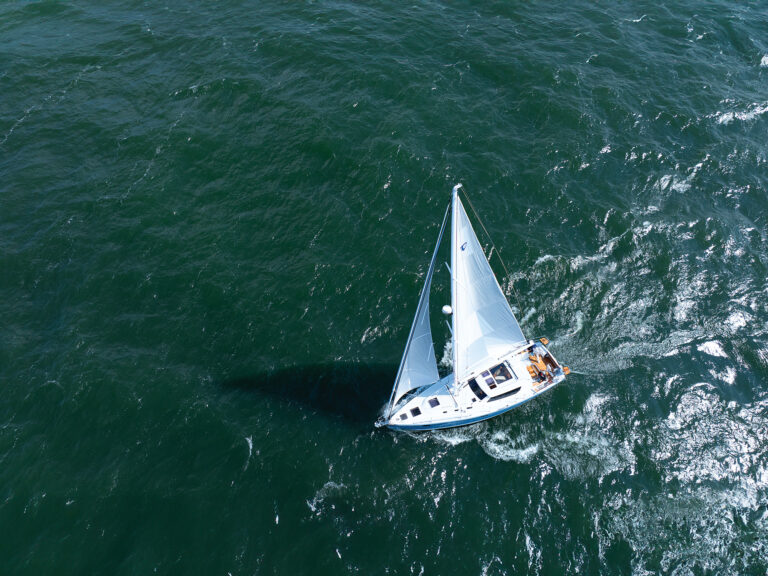
Miracle in a Bowl
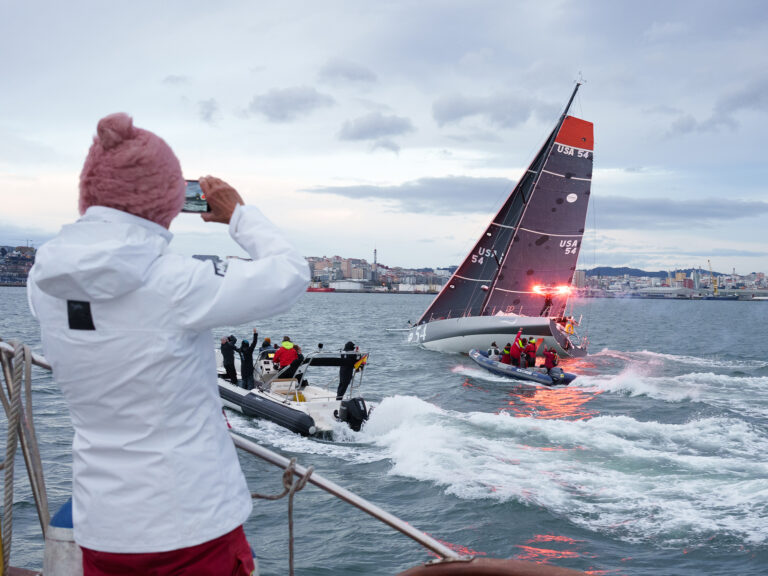
Cole Brauer Completes the Global Solo Challenge
- Digital Edition
- Customer Service
- Privacy Policy
- Email Newsletters
- Cruising World
- Sailing World
- Salt Water Sportsman
- Sport Fishing
- Wakeboarding
- The Ultimate Guide to Small Sailboats: From Dinghies to Ocean Cruisers
Ahoy there, maritime enthusiasts! Are you tired of being a landlubber and ready to take on the open waters? Have you ever caught yourself daydreaming about sailing into the sunset but thought that owning a sailboat was only for the wealthy or the experienced? The good news is that small sailboats are here to prove you wrong. Easy to maneuver, affordable, and incredibly fun, these little vessels offer a world of possibilities for novices and veterans alike. So, why not set sail on this journey and explore what small sailboats have to offer?
Types of Small Sailboats
Dinghies are like the hatchbacks of the sailing world—compact, practical, and surprisingly versatile. Usually measuring under 15 feet, they are the go-to boats for sailing newbies to cut their teeth on. Why? Because they're affordable and easy to manage. Think of a dinghy as your first bicycle—sure, you'll fall a few times, but the lessons learned are invaluable.
If a dinghy is a hatchback, then a daysailer would be your sporty coupe—ideal for a fun day out but not really for a week-long journey. These boats are a bit larger, typically ranging from 15 to 25 feet, and can comfortably accommodate 4 to 6 people. They're perfect for sailing close to shore, having a picnic on the water, or enjoying a beautiful sunset.
Looking for something a bit unique? The catboat could be your feline friend on the water. These boats are known for their single mast and mainsail, making them easier to handle. They’re the sort of boat that likes to lounge lazily in shallow waters but can also pick up the pace when needed.
Features to Consider When Buying
Hull material.
The hull is like the foundation of a house—if it's not strong, everything else fails. Generally, you'll find hulls made of fiberglass, wood, or even aluminum. Each material has its pros and cons. For instance, fiberglass is durable and low-maintenance but can be expensive. Wood offers a classic look but requires more upkeep.
Would you prefer manual or automatic transmission in a car? Similarly, the rig type of your sailboat affects your sailing experience. You might opt for a simple sloop with one mast and two sails or maybe a cutter with an additional headsail for better balance. The choice is yours.
Length and Beam
Here's where size really matters. The length and beam (width) of your boat will significantly impact its stability, storage capacity, and how it handles in different water conditions. It's not always that smaller is easier to handle; sometimes, a slightly larger boat offers better stability and amenities.
Advantages of Small Sailboats
Affordability.
Let's face it—owning a boat isn't cheap. But small sailboats make the dream more accessible. Not only are the upfront costs generally lower, but ongoing maintenance expenses like docking fees, cleaning, and repairs are also more manageable. It's the difference between owning a high-end sports car and a reliable sedan—both can be fun, but one is undoubtedly easier on the wallet.
Maneuverability
Remember the first time you parallel parked a car? Now, imagine doing that with a 40-foot boat! Small sailboats shine when it comes to maneuverability. They're easier to steer, quicker to respond, and a breeze to dock, making them perfect for navigating through narrow channels or crowded marinas.
Low Maintenance
Less is more when it comes to boat maintenance. Smaller surface area means fewer places for dirt and grime to hide, making cleaning easier. Not to mention, smaller engines (if your boat has one) mean less complicated mechanical problems to solve. It's like owning a plant that only needs water once a week—low commitment, high reward.
Popular Small Sailboats
Remember the Volkswagen Beetle of yesteryears? Compact, easy to manage, and immensely popular—that's what Sunfish is to the world of small sailboats. Whether you want to race or just sail leisurely, this boat is a versatile choice that won't disappoint.
For those who crave a bit more adrenaline, the J/22 is like the sports bike of small sailboats. Known for its speed, agility, and performance, this boat is a favorite in racing circles. It's agile enough to make quick turns yet sturdy enough to handle a variety of sea conditions.
Catalina 22
If you're looking for the minivan of small sailboats—functional, family-friendly, and reliable—the Catalina 22 is for you. Ideal for weekend trips with the family, this boat offers a cabin for shelter, a cooking space, and even a small toilet. It's a floating home away from home.
Small Sailing Yachts for Sale
Where to buy.
Buying a boat can be like buying a car; there are various avenues available. You can go through dealerships, check out classified ads, or even explore online platforms like Boat Trader or YachtWorld. Just like you wouldn't buy a car without a test drive, make sure to do a sea trial before making a purchase.
Price Range
The cost of your new aquatic venture can vary widely depending on the size, brand, and features. You might find a used dinghy for as low as $1,000 or a top-of-the-line daysailer that costs over $20,000. Therefore, it's crucial to budget not just for the initial purchase but also for the ongoing costs like maintenance, insurance, and docking fees.
(To be continued...)
Read our top notch articles on topics such as sailing , sailing tips and destinations in our Magazine .
Small Bluewater Sailboats
Definition and features.
When it comes to small sailboats, not all are built for the big leagues, aka open-ocean sailing. However, some compact beauties are fully capable of taking on the mighty seas, and these are commonly referred to as "bluewater sailboats." These boats generally have reinforced hulls, deep keels for added stability, and more robust rigging systems. They also often come with advanced navigation and safety features like radar and autopilot systems.
If you're serious about open-ocean sailing but don't want a massive boat, brands like Nor'Sea and Pacific Seacraft have some excellent offerings. These boats might be small in size (often under 30 feet), but they are big on features and sturdiness, designed to withstand challenging sea conditions.
Boats for Cruising
Characteristics.
A cruiser is like a comfortable sedan equipped for a cross-country road trip. Similarly, cruising boats are designed for longer journeys and typically feature amenities like sleeping cabins, cooking facilities, and even bathrooms. However, small cruising sailboats make these comforts available in a compact form, ensuring you don't have to compromise on luxury while also enjoying the benefits of a small boat.
The market offers various models to suit different cruising styles. If you prefer a classic, vintage look, the Bristol series offers some wonderful choices. Those who want a more modern flair might gravitate towards Hunter or Beneteau models. No matter your preference, there's likely a small cruising sailboat that fits the bill.
Very Small Sailing Boats
What makes them unique.
We're talking about boats usually under 10 feet, often even as small as 6 or 7 feet. These are the "motorbikes" of the sailing world—quick, nimble, and perfect for a joyride, albeit on water. What they lack in amenities, they make up for in sheer fun and the ability to go places bigger boats can't.
Very small sailing boats are perfect for specific types of water activities. You can use them for fishing, exploring secluded inlets, or just enjoying a peaceful day on the water. They are also excellent for teaching kids the basics of sailing due to their simplicity and ease of handling.
Small Ocean Sailboats
Ocean-capable small boats.
Yes, you read that right—there are small sailboats designed for ocean sailing. Unlike their cousins confined to more tranquil waters, these boats have features that make them seaworthy. However, don't assume that any small boat can be taken on an ocean voyage. Specific design features are essential for this kind of challenging adventure.
Essential Features
So what makes a small sailboat ocean-worthy? For starters, a strong hull designed to take on challenging sea conditions. You'd also want a deep keel for stability, a robust rigging system to withstand high winds, and multiple fail-safes like backup navigation systems.
Small Ocean Cruisers
Adaptability.
Ocean cruisers in a small size offer the best of both worlds—they are versatile enough for both coastal cruising and open-ocean voyages. These boats are like your all-terrain vehicles, capable yet compact.
Pros and Cons
While adaptable, small ocean cruisers may lack some of the luxury or speed that larger yachts can offer. However, their versatility and ease of handling often make them a popular choice for those who like a variety of sailing experiences.
Small Cruising Sailboats
Ideal for beginners.
If you're a rookie in the world of sailing, a small cruising sailboat could be your best bet. These boats are typically easy to handle, straightforward to maintain, and offer enough amenities for short trips—making them an ideal starting point.
Popular Models
If you're new to cruising, a couple of models might catch your attention. The Compac 16, known for its easy handling and classic look, is often recommended for beginners. Another excellent option is the Catalina 18, which offers a bit more room without compromising ease of use.
Setting sail on a small sailboat opens up a world of opportunities—whether you're a seasoned sailor looking for a weekend thrill or a beginner aiming for a long-term commitment to the sea. Understanding the types, features, advantages, and options in the small sailboat market will help you make an educated choice. The sea is vast and welcoming, offering adventures and tranquility alike, and a small sailboat can be your perfect vessel for exploration.
So what are you waiting for ? Take a look at our range of charter boats and head to some of our favourite sailing destinations .
Faqs: more about small sailboats, what's the best small sailboat for beginners, can small sailboats be used for ocean sailing, how much does a small sailboat cost, what features should i consider when buying a small sailboat, do small sailboats have sleeping accommodations.
Better Sailing
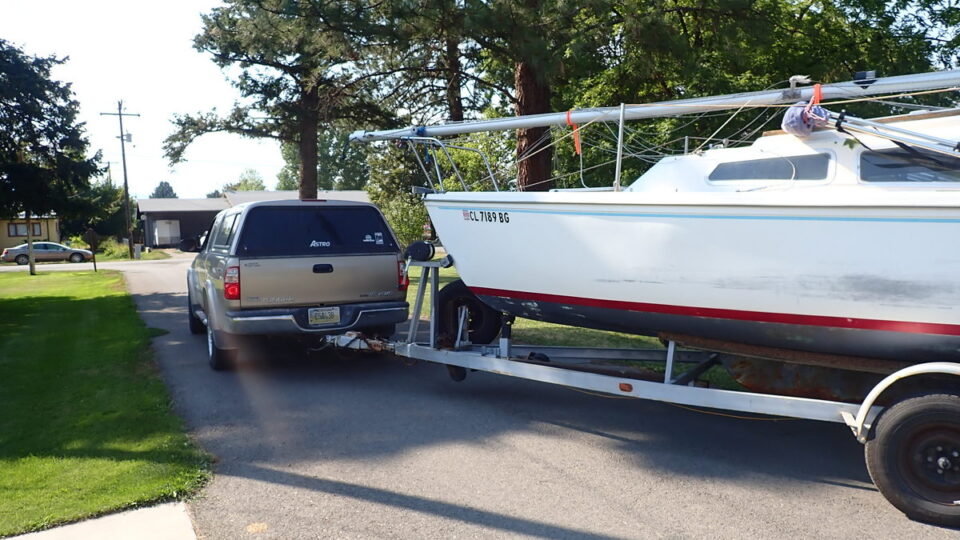
Best Small and Trailerable Sailboats
Cruising with a trailerable sailboat means that you can voyage in a small and comfy sailboat with the advantage of saving some serious costs. Having a trailerable sailboat saves you money for storage fees, boatyard haulout, and boat insurance, among others. There are two main categories of trailerable sailboats; performance-oriented boats and all-round pocket cruisers. So, if you’re a part-time sailor but still want to experience the joys of sailing continue reading this article so as to find out which are the best small and trailerable sailboats on today’s market. Know that there are many decent trailerable sailboats that managed both offshore and coastal cruising. So, keep reading and find the one that suits you best!
Catalina 22 Sport – The Best Trailerable Sailboat
Catalina brand is one of the most constructed sailboats in the US and has manufactured a great deal of capable and robust sailboats. The Catalina 22 Sport is one of the most preferred pocket and race cruisers since 2004. The model pioneers for the one-piece hull liner that has become standard in most high volume small boats. Furthermore, it has enough trim along with a well-proportioned rig and a hand-laid fiberglass hull construction. Other great features include a retractable lead keel, a roomy cabin, a spacious cockpit, and a fractional rig with a mainsail and a roller-furling jib. You can get a used Catalina 22 for as low as $5,000 and a brand spanking new one for around $40,000.

>>Also Read: Beneteau vs. Catalina: Which Is a Better Sailboat?
West Wight Potter 15
The West Wight Potter 15 is one of the best small trailerable and seaworthy 15-foot sailboats of all time. It’s easy to handle and great for both coastal and offshore cruising. She has an aluminum mast and tiller, a small cabin that comfortably sleeps a couple and also we can’t miss referring to her elegant design. Furthermore, it can be easily stored, it’s relatively cheap to buy and can be purchased both as a new or used boat, as many sailors prefer it for stepping up from a dinghy to a pocket cruiser.
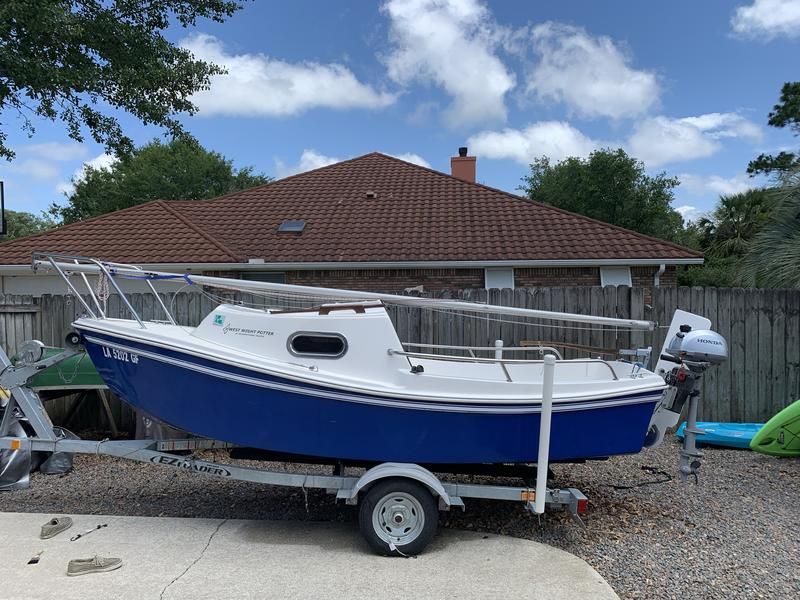
>>Also Read: Best Pocket Cruisers Under 20 Feet
This small trailerable boat features a modern design and can be a top choice for many sailors, both for beginners or even for experienced ones. She surprisingly manages well in different weather conditions and she’s also relatively easy to handle. As a result, she has earned by right the title of a truly seaworthy small cruising vessel. Moreover, her robust design from the masthead to keel design is proven to be highly durable and comes with a mainsail and 110% genoa. A great feature of this model is the comfy and interior layout that offers a great amount of space for her size.
And that’s why the Hunter 27 is a great liveable sailboat having enough storage space, 6ft of standing headroom, berths, as well as plenty of counter space and seatings. Lastly, as a true trailer sailor, she has a shoal draft of under 4ft and a displacement of less than 8,000lbs. You can find her in today’s market as a used or brand-new model with a price ranging from $20,000 to $45,000.
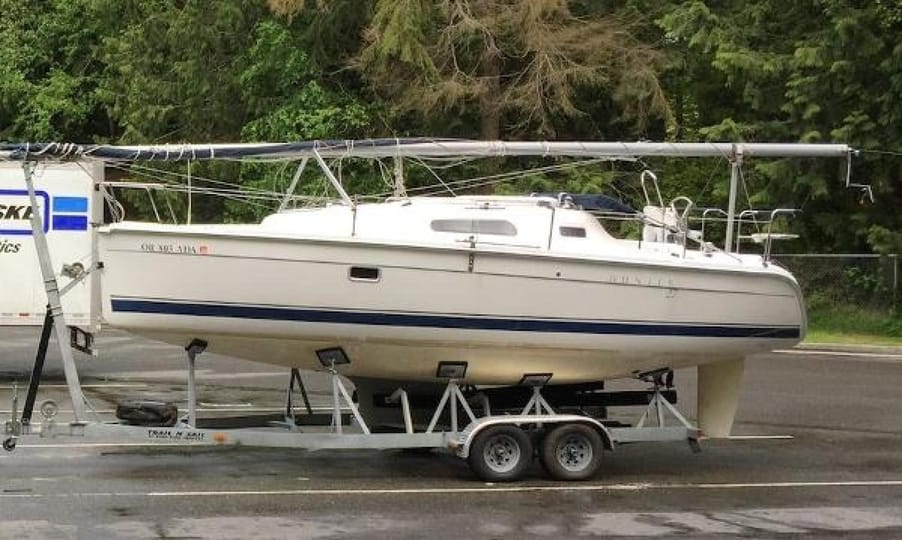
>>Also Read: Best Sailboats Under 100k
BayRaider
The BayRaider from UK’s Swallow boats is a somehow newcomer to the small trailerable boat market in the US. She features a large and open cockpit, is ketch-rigged, and has a gunter-style mainmast. As for the topmast and mizzen, they’re both carbon-fiber; you can also apply this to the mainmast. This model can be sailed with a dry hull in lighter weather conditions or if you want to maximize its stability you can do so by removing the 300lbs of water ballast. The water ballast offers great performance in light to medium winds and makes the boat suitable for different sailing or weather conditions and levels of experience. Lastly, as she has the centerboard and hinged rudder raised she can be maneuvered even in the thinnest water. She has a self-tacking rig and is easy to trailer; all these features make her a great choice for novices.
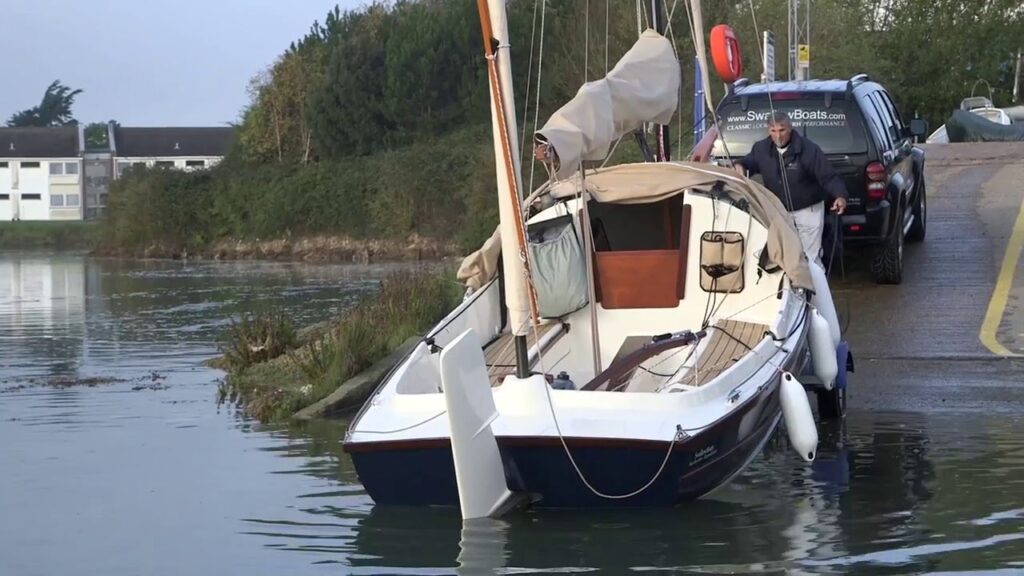
>>Also Read: Most Popular Sailboats
Contessa 26
The Contessa 26 is an all-time-classic and small trailerable sailboat. Even if this vessel is quite small she has proven her seaworthiness and is still preferred as an ideal pocket cruiser. She has a roomy cabin and comfortable cockpit, so there’s no need to worry about below deck space. As for the rigging, it’s quite easy to handle and is rigged as a masthead sloop. Also, her construction comprises of a deep keel and hull-mounted rudder; and that’s why she was also used as a racer. The main downside is her narrow beam which contributes to heeling although she stiffens up quickly and becomes easy to sail. In any case, there are many who admit that she’s one of the most reliable sailboats in the mid-size category.
The Hunter 22 is a great daysailer and features an open-transom cockpit and sloop rig, making her the ideal choice for friends and family outings. Moreover, the considerable amount of below-deck space has twin bunks, a roomy cabin, and a portable toilet. Rigging also includes an asymmetric spinnaker and a mainsheet traveler in case you’re keen on racing. Her construction is made out of laminated fiberglass hull and deck, molded-in nonskid, and a hydraulic lifting centerboard. Last but not least, she’s fast, stable, responsive, and is, therefore, an ideal starter-boat for novices.

Islander 24
The 24-foot Islander is a classic choice in the small trailerable sailboat market. This fiberglass model features a sturdy design and has proven her seaworthiness for coastal and family-day cruising. This model was first built in 1961 but is still available on the used market. She has a masthead sloop rig, simple overall rigging, and is appropriate for single-handing. As for below-deck space, she has a spacious cabin for two with a V-berth, and space for a head. Last but not least, many sailors admit that she’s a lot more capable than many of the later model boats in this size range.
>>Also Read: Best Sailboats Under 30 Feet
Macgregor 25
This trailerable cruising sloop is a safe, easy-handling, and robust sailboat for 2 persons; perfectly suitable for coastal cruising. The boat has a spacious cabin and great safety features like foam flotation as well as the ability to self-right. Its innovative design features a retracting keel, pop-up rudder, and an easy mast-stepping system that enhances its cruising performance. Moreover, it has a large foredeck and cockpit and its lifelines and shrouds are equipped with handholds. You can easily find a Macgregor 25 on the used market with just $9,500.

>>Also Read: Best Small Sailboats To Sail Around The World
Cape Dory 28
The Cape Dory 28 is a popular trailerable sailboat known for its great performance both offshore and inland. Even though it has a small size it offers comfortable living spaces below the deck. In addition, she has proven to be more capable than other larger sailboats. It’s designed with a well-balanced deck arrangement along with a full-length keel with an attached rudder, a low freeboard, and a well-proportioned traditional trunk cabin. These sailboats were originally rigged as sloops with self-tending and club-footed jibs. This sail plan is really great for stiff weather conditions. Lastly, it can be easily hauled-out and transported regardless of its 28ft size. Ideal for salt-water cruising and for tighter coastal waters you can find a used model for $12,900.
>>Also Read: How Much Do Sailboats Weigh?
The Newport 27 is an all-time-classic that was first built in 1971 and is still considered a common choice for small sailboats amongst sailors. Although it has a small size it doesn’t lack interior space. The standing headroom is just over 6ft, there’s a V-berth, a head, and a hanging locker forward of the bulkhead. Also, settees measure 6ft in length and extend to either side of the saloon. Some variations include a fixed dinette with raised seating fore and aft, a starboard quarter berth, and an aft-placed head. You can find them on the used market from $10,000 to $18,000, depending on their condition and any possible upgrades. Even though it’s not a really robust offshore cruiser, the Newport 27 is still a capable trailerable sailboat and if upgraded and equipped accordingly it can definitely offer decent coastal cruising to a singlehander or a couple.
>>Also Read: What Are The Best Beginner Sailboats?
Trailerable sailboats are a great choice for beginner sailors as well as for couple and family outings. Keep in mind that the aforementioned boats are not the only options on today’s market. I recommend these boats because they’re easy to handle, small but roomy, easy to trailer, and have an overall robust design. Generally, a trailer sailor will save you costs for purchasing but also for marina fees. Keep in mind that many sailors choose to sail overseas with a trailerable sailboat, so there are suitable models for a long-passage voyage. Lastly, small sailboats can offer different kinds of sailing adventures; weekend cruising, coastal cruising, island hopping, and sometimes an offshore voyage. I hope that you enjoyed reading this article and that it will help you out in order to pick the right trailerable sailboat for your needs.
Peter is the editor of Better Sailing. He has sailed for countless hours and has maintained his own boats and sailboats for years. After years of trial and error, he decided to start this website to share the knowledge.
Related Posts

The Ultimate Guide to Choosing the Best Fishing Line for Trolling

Lagoon Catamaran Review: Are Lagoon Catamarans Good?

Best Inboard Boat Engine Brands

Are O’Day Sailboats Good? A Closer Look at a Classic Brand
- Buyer's Guide
- Destinations
- Maintenance
- Sailing Info
Hit enter to search or ESC to close.
Best Small Sailboats for Beginners
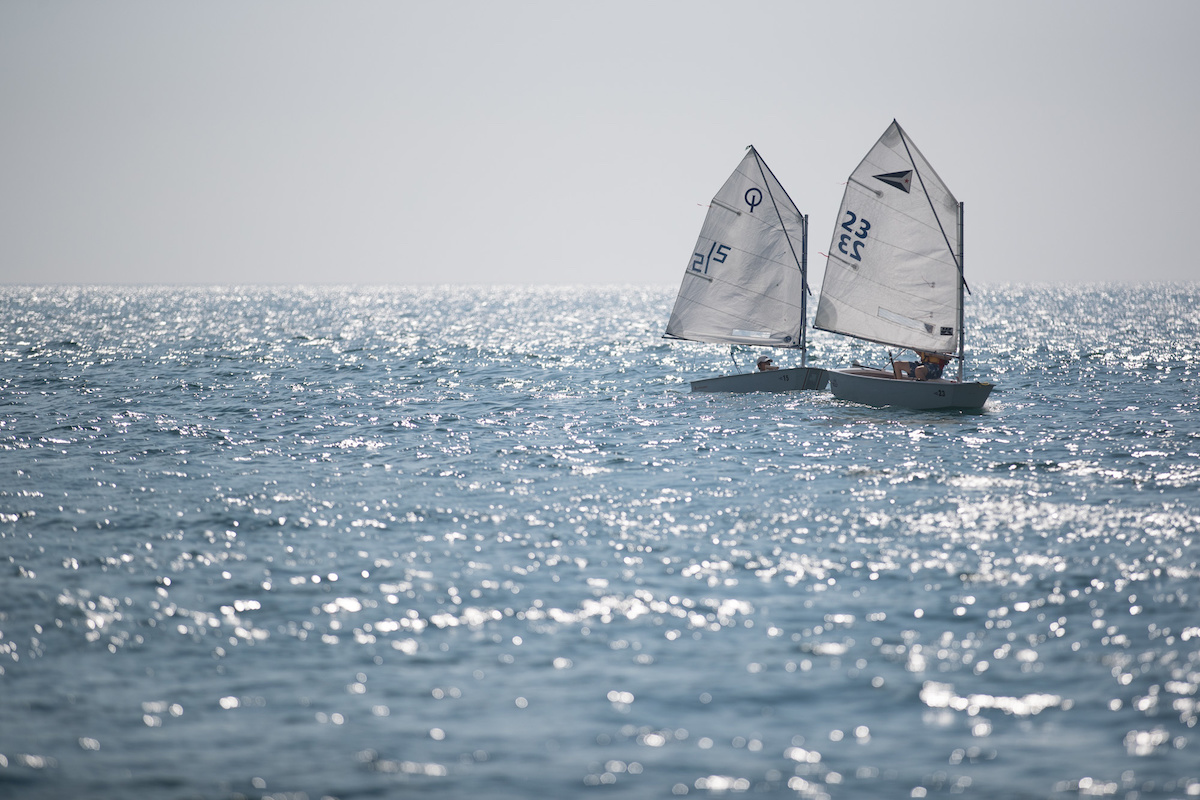
There are a number of classic trainers used by yacht club youth programs as well as techie new designs. Without mentioning specific models and brands, it’s difficult to outline which small boats are best but here are things to look for in good teaching boats.
Some of the best small sailboats for beginners include:
- Boats with tillers steering
- Boats with no winches
- Sailing dinghies
- Small sloops
- Small catamarans
- Rotomolded boats
- Trailerable sailboats
Explore All Sailboat Types
Boats with Tiller Steering
Steering by tiller (rather than a wheel) can make a difference when learning. Tillers are directly connected to the rudder that manages the boat’s direction. Tillers provide quick feedback about the strength and direction of the wind as well as the boat’s turning agility at various speeds.

Boats with No Winches
Boats that require no winches to manage the sheets and halyards are best for youngsters and new sailors. These boats usually don’t experience the same forces on the sails and rigging as larger boats, which can be a handful when the wind starts to blow. Winches are usually replaced with cam or jam cleats, which are easy to use.
Sailing Dinghies
Sailing dinghies are usually rigged with one mast and one sail and offer kids and new sailors simplicity so it’s easy to learn the ropes. Less overwhelming than boats with two sails, dinghies are light and responsive. They also have a shallow draft due to side or centerboards so they can be sailed just about anywhere. In some cases (whether from a wind gust or sudden crew weight shift) sailing dinghies can capsize so students should wear lifejackets and know how to swim. Sailing dinghies are usually sailed by one or two people.
Small Sloops
Small sloops with a mast that carries head and mainsails are the next step so students learn how sails work together. Headsails can be hanked on or attached to a small roller furler. These boats may have some or no winches, which also makes them easier to maintain. These boats can usually be sailed with one to four people.
Some sloops can scale up, providing a more challenging experience for sailors as they develop skills. Certain models can carry spinnakers and larger headsails to teach sail combinations and new sail trim techniques. Others offer the ability to hike out (shift crew weight well outboard to balance the boat against the wind pressure in the sails). This kind of sailing is more advanced.
Small Catamarans
Small catamarans provide extra stability for those who may be nervous about capsizing or aren’t fond of heeling (tipping while sailing). With two hulls providing a wide and stable base, catamarans area ideal for beginners, which may be why they’re often used by resorts as their beach sailing tourist boats. Rigged with one or two sails, small cats are tiller steered and usually have a trampoline that the students sit on and sail.
Rotomolded Boats
Small rotomolded boats are very forgiving due to their durable construction. Unlike fiberglass or wooden boats, rotomolded (a type of plastic construction technique) trainers can bounce off docks or other boats and cause or sustain little damage. Dinghies and catamarans can both be made via rotomolding.
Trailerable Sailboats
Finally, small sailboats that can be trailered to different locations add variety and that makes learning fun. Students can learn to sail in different wind and water conditions and enjoy their boats differently on vacation or with new friends.
Learning to sail involves all the senses and requires a level head and lots of practice and although it can be learned in many ways, the best way is to start with a boat that’s small, simple, safe and durable.
Read Next: Small Boats: What Are My Options?
You Might Also Like:
- Sailing Basics: 10 Nautical & Sailing Terms to Know
- Learning the Basics of Sailing
- Why Sailing?
- Find the Right Boat for Your Lifestyle
- Explore Sailboat Brands
Join Our Newsletter!
Get community news, buying bargains, and how-to guides at your fingertips.
- Articles and Guides
Small Sailboat Types: A Guide to Choosing the Perfect Vessel
9th mar 2023 by toi williams.

Learning how to sail can lead to years of fun and adventure, and having the right sailboat can make your experiences on the water even more enjoyable. Small sailboats have increased in popularity over the last few decades as more people have taken up sailing as a hobby, and today, many types of small sailboats are available for various types of activities.
So, what small sailboat types could be right for you?
Types of Small Sailboats
The term "small sailboats" encompasses a wide range of sailboat models. Generally, if a boat is less than 25 feet long and has a mast, rudder, and sail, it is considered a small sailboat. Various types of small sailboats have different characteristics that make them better for certain types of sailing. Here are some of the most popular small sailboat types.

Sailing dinghies
Sailing dinghies are frequently chosen because they are light and responsive. They are usually rigged with one mast and one sail, making them easy to handle, and they have a shallow draft, allowing them to be used almost anywhere. Sailing dinghies are also some of the least expensive sailboats because they tend to be simple with few features.
Laser – Laser sailing dinghies are nearly 14 feet long and weigh about 130 pounds, making them easy to maneuver and transport.
Beetle Cat - Beetle Cat sailing dinghies are roughly 12 feet long and have a draft of 2 feet, which makes them great for coastal cruising.
Sunfish - The Sunfish has a simple 14-foot setup and is ideal for those who want to learn how to sail.
Catalina 16.5 - The Catalina 16.5 is slightly over 17 feet long and can draft as low as 5 inches on the water.
RS Venture – The Venture model from RS Sailing is 16 feet long and is often used in training classes for those new to sailing.
RS Aero – The Aero model from RS Sailing is nearly 14 feet long and is known for its speed, making it popular with experienced racers.
Topaz Taz – At slightly under 10 feet in length, the Topaz Taz is one of the smallest sailing dinghies currently available.

Topaz Taz. Photo credit: Topper Saliboats
Daysailer is a broad categorization of small sailboat types based on usage and size. Daysailers, also known as dayboats, are larger than sailing dinghies and are available with or without sleeping accommodations. At Rightboat, we list a large selection of daysailers in a wide variety of styles.
Marblehead 22 – The Marblehead 22 is a daysailer with a cockpit that is nearly 12 feet long. It has plenty of room to seat several people.
Catalina 22 Sport – The Catalina 22 Sport daysailer is nearly 22 feet long, can sleep four people, and has a retractable keel for a draft of less than two feet.
Cape Cod Daysailer – This 16-foot sailboat is one of the most affordable models for its size and has enough room to seat several people comfortably.
West Wight Potter P19 – The P19 model from West Wight Potter is just under 20 feet long and comes with four berths, a galley, a sink, and a stove.
Sun Cat – This daysailer from Com-Pac Yachts is nearly 18 feet long and has twin 6-foot berths as well as a handful of other useful amenities.

Photo credit: Zurn
Small sloops
Small sloop is another popular category of small sailboat types. These sailboats are easy to maintain and easy to learn to control and maneuver. They are characterized by a single-mast rig, which typically has a triangular mainsail and a headsail. Small sloops can usually be sailed with one to four people aboard and can be used for all types of sailing in different conditions.
Montgomery 17 – This small sloop has a length of roughly 17 feet and a retractable centerboard keel that can make the boat draft just 2 feet.
Super Snark - The Super Snark is 11 feet long and weighs just 50 pounds with a payload capacity of about 310 pounds.
Flying Scot - At just under 20 feet in length, the Flying Scot is one of the larger small sailboats, allowing it to comfortably seat up to eight people.
BayRaider - The BayRaider is nearly 20 feet long with most of that space occupied by an open cockpit.
Small catamarans
Small catamarans are a good choice for sailors who want some extra stability on the water. These sailboats have two hulls that create a wide and stable base and can be rigged with one or two sails. Small catamarans are often used for cruising, fishing, and racing.
Hobie 16 - The Hobie 16 is slightly less than 17 feet long and is known for being fast, making it very popular with speed-loving sailors.
Minicat - Minicat has developed a line of inflatable catamarans with multi-piece masts that are available in various sizes.
More information: Buying A Sailing Catamaran

Photo credit: Hobie
Advantages of Small Sailboats
There are many reasons why you might prefer one of the small sailboat types over a larger model. Here are some of the most common reasons for choosing small sailboats.
Small sailboats are easy to sail
Small sailboats are often easier to sail because their rigging and steering are simpler. Small sailboats also react quicker to wind shifts, putting sailors more in tune with their surroundings.
Small sailboats are more affordable
The simplicity of small sailboats means you won't be paying a higher price for a bunch of features you don't need. If you choose to buy a certified used sailboat from our experts at Rightboat, you can save even more.
Small sailboats are easier to maintain
Maintenance needs for a small sailboat can be considerably less than what is necessary for their larger counterparts, saving you a significant amount of money over the life of your boat. The model and brand you choose are the biggest factors determining how easy it will be to maintain the boat.

Disadvantages of small sailboats
While there are a lot of things to like about small sailboats, they can also present some challenges in different types of sailing conditions. Here are some reasons why a smaller sailboat may not be the best choice for you.
Small sailboats sail slower
The smaller sails and hull of these types of sailboats make them go slower in the water when compared to larger sailboats. Unless a small sailboat is specifically designed for racing, do not expect it to travel very fast offshore.
Small sailboats have less space
While space is limited on all types of boats, this is especially noticeable with a small sailboat. This lack of space can make it difficult to plan extended trips without frequent stops to replenish your supplies.
Small sailboats have fewer comforts
Small sailboats are typically designed to be simple to launch and operate, so many of the comforts found on larger sailboats are absent on smaller models. In many cases, small sailboats do not have much seating and lack a galley for food preparation or a berth for sleeping.
Many factors go into choosing the right type of boat for your needs. While small sailboats are effective for a variety of purposes, they can present some challenges in certain conditions. At Rightboat, you can find the best boat for your sailing goals and your budget.
For more information check out our guide:
What are the Different Types of Sailboats?
Choosing the Best Beginner Sailboat
Written By: Toi Williams
More from: Toi Williams
Related Articles and Guides
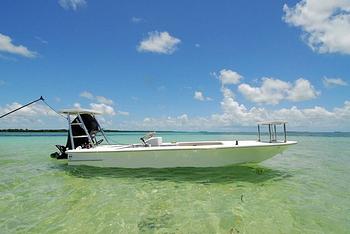
4th Mar 2024
The Best Flats Boats Brands, Special Boats for Skinny Waters
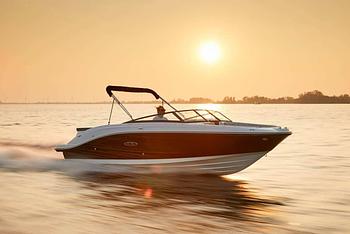
21st Feb 2024
Best Lake Boat Brands for Fishing, Cruising, and Watersports

15th Feb 2024
Best Aluminum Fishing Boat Brands: Tougher, Lighter and More Affordable
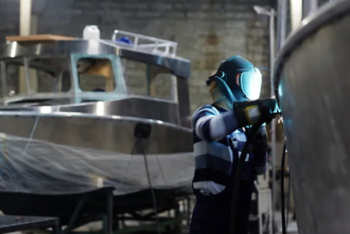
2nd Feb 2024
Aluminum vs Fiberglass Boats: Which is Best and Why?
- Explore Rightboat
- Boats for Sale
- Boating Articles
- Buyers Guide
- About RightBoat
- Sell Your Boat
- Boat Selling Advice
Enter your email to keep up to date with the latest news
Join for free
Sign up now for free and discover how easy it is to keep up to date with THE latest boats for sale. Find your right boat, and tailor your voyage to finding your next boat.
Benefits of becoming a member:
- Set up tailored alerts
- Personalise your experience
- Download full specifications and broker details
- Keep tabs on your favourite boats
Are you a broker? Join as a Broker
Rightboat - join for free.
Do you have an account already? Login
Save this search
Save your search and receive new boats in your email..
You can unsubscribe from your alerts whenever you like. By pressing the button you accept the Legal Terms and conditions
Click on the button to load the content from www.googletagmanager.com.
Load content

- Tailored Vacation Planner
- Cabin Yacht Charter
- Family Sailing Holidays
- Romantic Sailing Vacations For Couples
- Sailing with friends
- Greece all inclusive yacht charter
- Croatia all inclusive yacht charter
- Food & Wine Routes
- Yacht search
- Luxury sailing
What are the Best Small Sailboats Under 20 Feet?
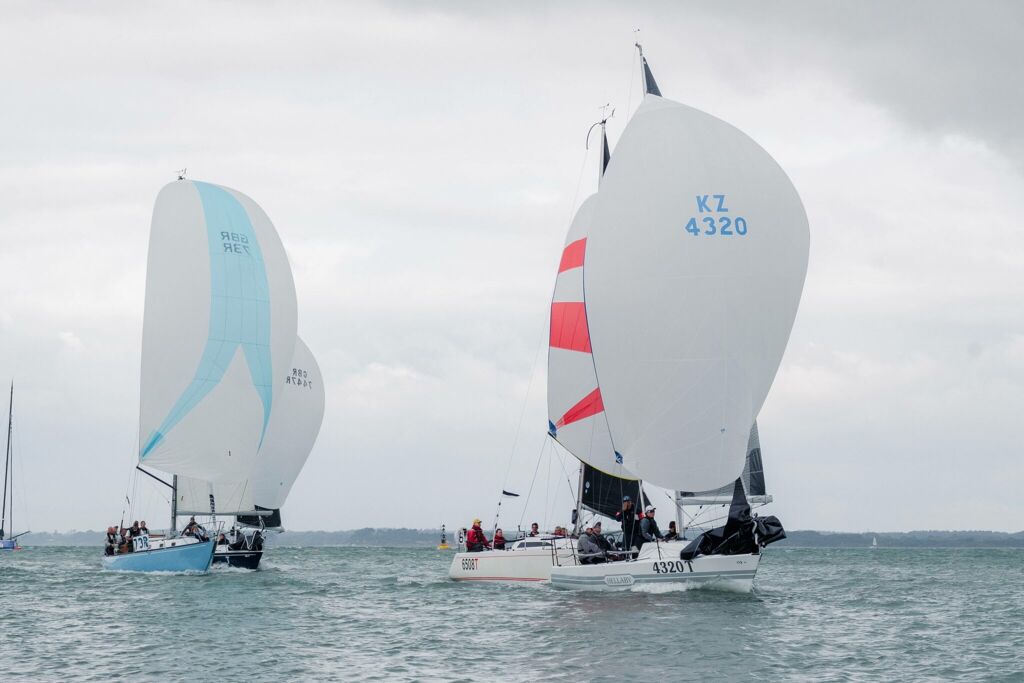
Sailing is a timeless and exhilarating activity that allows individuals to connect with the wind, water, and nature in a way that few other pastimes can match.
While sailing often conjures images of grand yachts and vast open waters, there’s a thriving community of sailors who prefer smaller vessels that offer a more intimate and agile experience.
In this blog post, we’ll take a closer look at some of the best small sailboats under 20 feet, highlighting their features, performance, and why they stand out in the world of sailing.
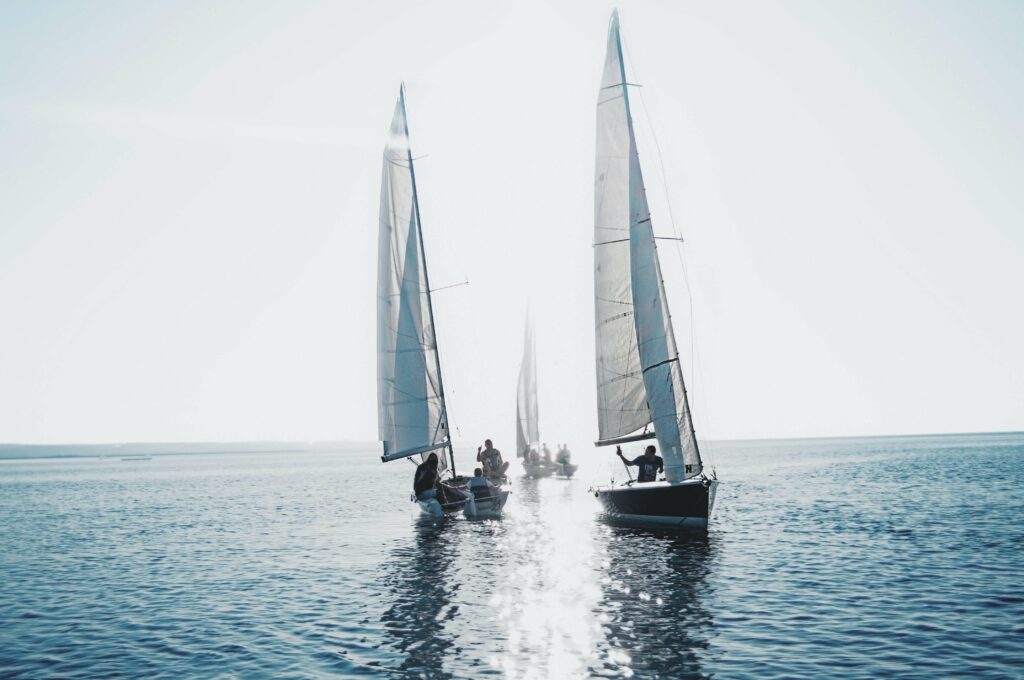
The Hunter 17 is a charming and capable small sailboat designed to provide a fantastic sailing experience for both beginners and seasoned sailors. With a length of 17 feet and a beam of 7 feet, it strikes an ideal balance between manoeuvrability and stability.
Key Features:
A. Spacious Cockpit: Despite its compact size, the Hunter 17 boasts a surprisingly spacious cockpit that can comfortably accommodate up to six people. This design makes it an excellent choice for family outings or weekend adventures with friends.
B. Swing Keel: The swing keel design allows for shallow draft sailing, meaning you can explore shallow waters without worry. It’s a versatile feature that expands your sailing horizons.
C. Easy to Rig: One of the Hunter 17’s standout features is its simplicity in rigging. Setting up and launching this sailboat is a breeze, making it accessible to those new to sailing.
D. Stability: The boat’s stable design and responsive handling make it a great choice for beginners. Even when the wind picks up, you’ll feel confident and in control.
Performance:
The Hunter 17 offers a respectable level of performance, with its responsive helm and well-designed sails. While it may not be the fastest boat in its class, it offers a smooth and enjoyable ride, perfect for leisurely cruising and day sailing.
O’Day Javelin
The O’Day Javelin is another excellent small sailboat option, known for its simplicity, reliability, and affordability. With a length of 14 feet and a manageable sail area, it’s an ideal choice for those looking to get started in sailing without breaking the bank.
A. Simple Rigging: The Javelin features a straightforward rigging system, making it easy for beginners to set up and launch the boat. This simplicity is a significant advantage for those new to sailing.
B. Lightweight and Trailerable: The Javelin is lightweight, making it easy to trailer to different bodies of water. This portability allows you to explore a variety of sailing locations.
C. Durability: O’Day sailboats are known for their durability, and the Javelin is no exception. With proper care and maintenance, this sailboat can provide years of sailing enjoyment.
While the O’Day Javelin may not be the fastest sailboat on the water, its focus on simplicity and reliability makes it an excellent choice for beginners and those looking for a hassle-free sailing experience. It’s a forgiving boat that allows you to learn the ropes at your own pace.
Catalina 18
The Catalina 18 is a small sailboat that bridges the gap between compact boats and larger cruisers. With a length of 18 feet, it offers a bit more space and comfort while maintaining the agility and excitement of a smaller vessel.
A. Comfortable Cabin: The Catalina 18 features a small but comfortable cabin, providing a place to escape the elements or even spend a night on the water. This feature sets it apart from many other small sailboats.
B. Self-Righting Design: The boat’s keel design makes it self-righting, which means it can recover from a capsize easily. This safety feature is especially reassuring for novice sailors.
C. Responsive Handling: Despite its slightly larger size, the Catalina 18 maintains responsive handling, making it enjoyable to sail in a variety of conditions.
The Catalina 18 offers a good balance of performance and comfort. While it may not be as fast as some dedicated racing sailboats, it’s a capable cruiser that can handle a range of wind conditions. The inclusion of a cabin adds versatility to your sailing adventures, making it an excellent choice for day trips and overnight excursions.
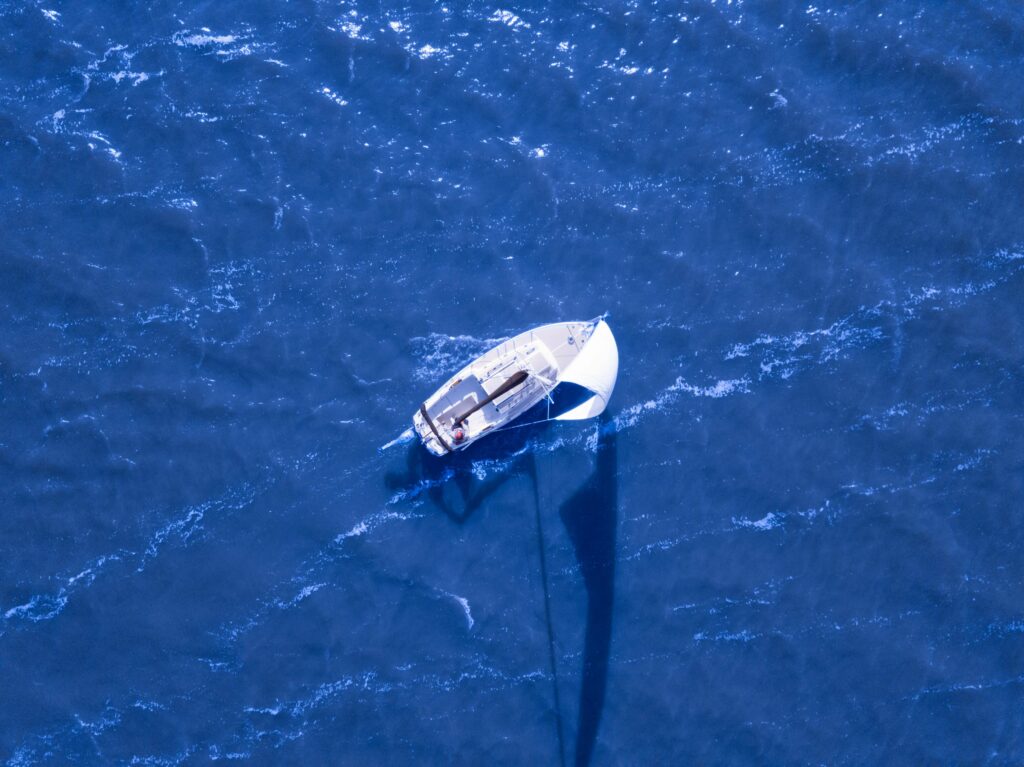
Conclusion :
Choosing the best small sailboat under 20 feet when you are getting ready to sail ultimately depends on your preferences and sailing goals. The Hunter 17 offers a spacious cockpit and stability, making it an excellent choice for families and beginners. On the other hand, the O’Day Javelin focuses on simplicity and affordability, making it an accessible entry point into the world of sailing. Lastly, the Catalina 18 strikes a balance between performance and comfort, with the added bonus of a cabin for overnight stays.
Regardless of which small sailboat you choose, each of these options provides a unique sailing experience. Whether you’re seeking adventure, family sailing , relaxation, or a way to connect with nature, these boats have something to offer. So, set your sails and embark on your sailing journey with confidence, knowing that you’ve chosen one of the best small sailboats under 20 feet to accompany you on your maritime adventures.
Determining the absolute safest sailboat in the world is challenging, as safety can depend on various factors, including the crew’s experience, weather conditions, and maintenance. However, sailboats designed for offshore cruising, such as those from renowned manufacturers like Hallberg-Rassy or Oyster, are often considered some of the safest due to their robust construction and advanced safety features.
The most efficient sail shape varies depending on the specific point of sail and wind conditions. However, in general, an aerodynamically curved shape, similar to an airfoil, is often considered the most efficient for harnessing wind power and generating forward propulsion on a sailboat.
A sailboat size suitable for two people typically ranges from 20 to 30 feet, with 25 to 30 feet being a popular choice for couples. This size provides enough space for comfortable living quarters and maneuverability while still being manageable for a two-person crew.
The size of a sailboat that one can single-hand largely depends on the sailor’s experience, skills, and the boat’s design. Many experienced sailors can comfortably single-hand sailboats up to 35-40 feet, but with the right equipment and know-how, even larger vessels can be handled solo.
Share article:
Have a question.
We have answers to your questions. So don’t hesitate to get in touch with our team today!
- GET MORE INFO
Feel free to ask us anything. All hands on deck. Let's sail
Thank you for sending us an inquiry, thank you so much for your enquiry.
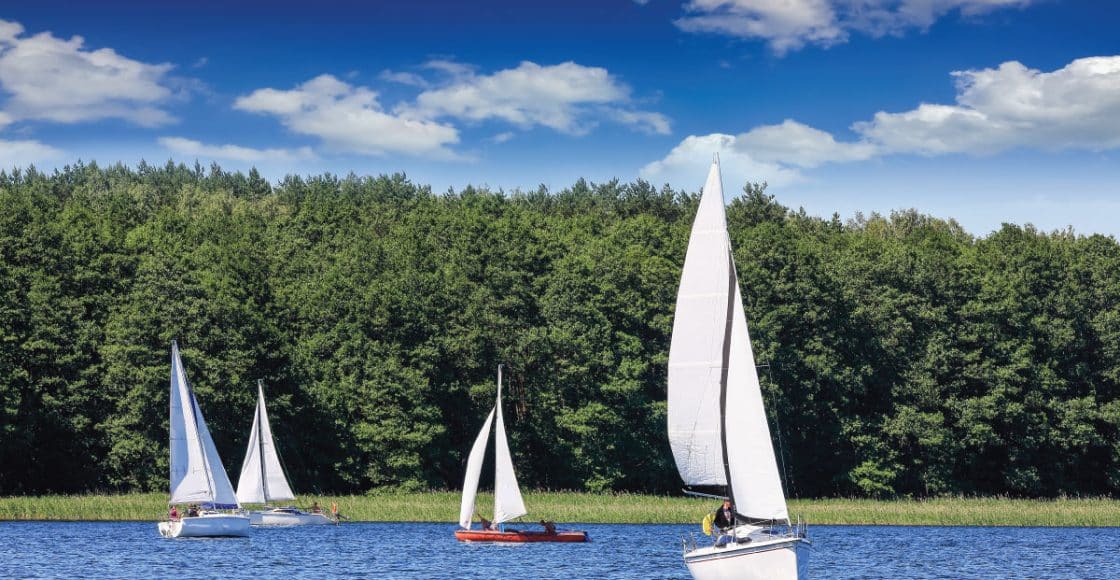
10 Best Sailboats for a Fun Lake Day

Table of Contents
Sailing on lakes can be fun, especially if the wind is steady and the water is relatively flat. Although a 50-foot sailboat wouldn’t go amiss on Lake Superior, most lakes are perfect for smaller, more lightweight boats.
For inland waterways, it’s best to find compact sailboats under 30 feet with a centerboard or swing keel so they can be trailed from one lake to another. A tabernacle or collapsible mast that folds or is removable also comes in handy.
Finally, there’s a difference between a small open sailboat for day outings and one with a bunk and a head (toilet) so you can camp aboard for the weekend. Let’s look at a mix of 10 older and newer boats perfect for lake sailing.
- Catalina 22 (25 & 27 also available)
Discover sailboat rentals for a lake day near you
1. Optimist
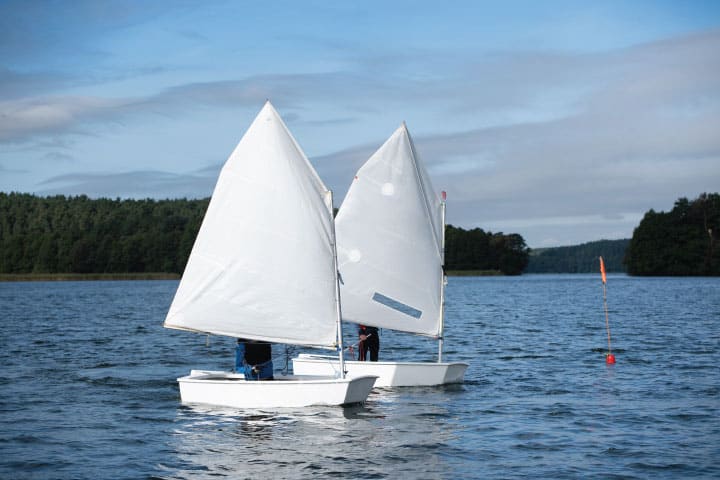
The Optimist sailing dinghy weighs under 80 pounds and is virtually unsinkable. They’re easy to find since over 100,000 hulls have been sold.
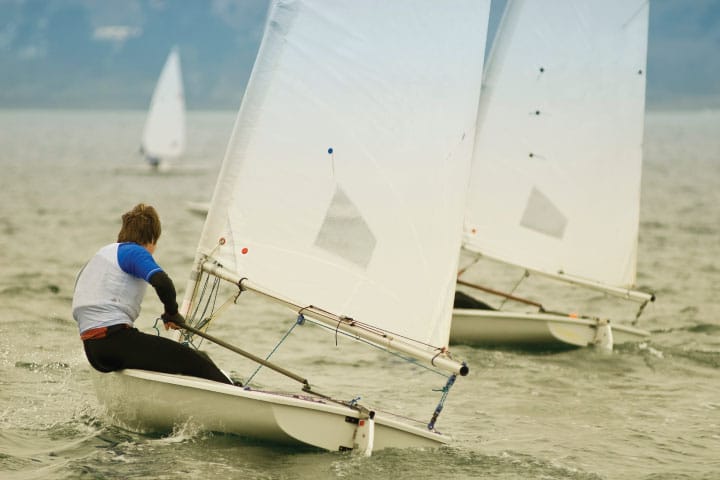
Designed in the 1970s, the Laser is a simple sailboat with a single sail and room for one. It’s very popular with one-design racers.
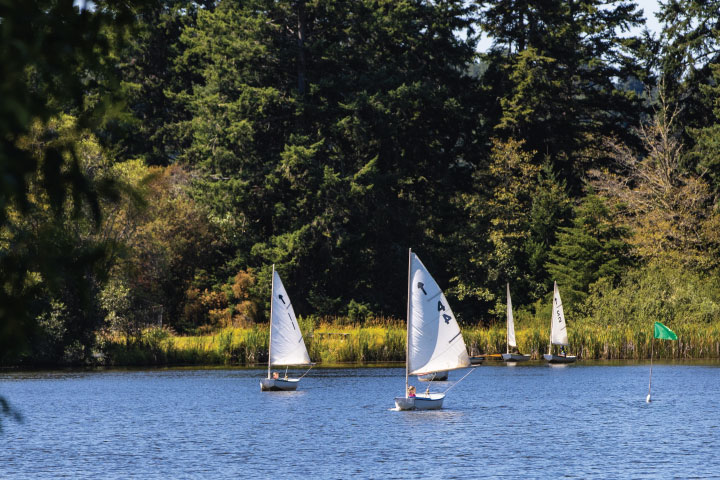
A workhorse in yacht club youth sailing programs, the Sabot is a sailing dinghy with a centerboard that is perfect for kids to learn the ropes – literally.
This open 14-footer was first built in 1958 and developed quite a following with dinghy sailors. It has a fractional rig and a centerboard and can be sailed by one or two.
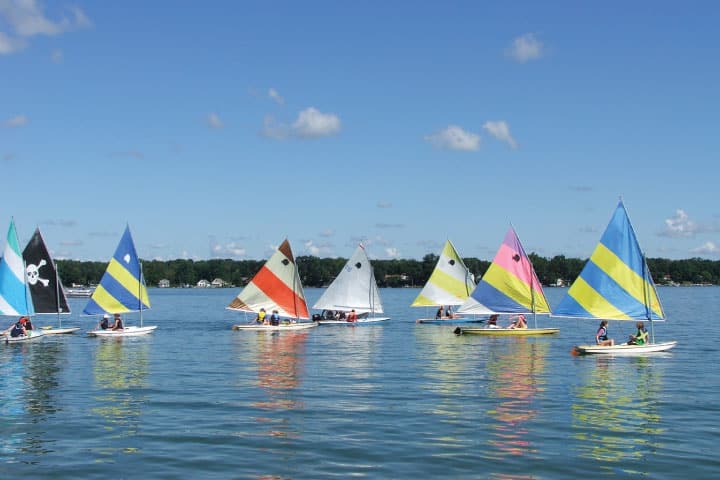
The Sunfish is more sophisticated than a typical sailing dinghy and can carry two adults since it’s 14 feet long. It’s a great boat on which to master racing skills.
6. Harbor 20
A fast and contemporary daysailer, the Harbor 20 was conceived on a bar napkin by fellow yacht clubbers, and its appeal has grown worldwide since. Fast and fun, the Harbor 20 even has a small electric motor hidden in the transom .
7. Alerion 28
Smart and sophisticated, the Alerion 28 turns heads with its impressive lines. With classic East Coast styling, the Alerion 28 has a beautifully appointed interior with all the amenities a couple would need for weekending.
8. Hobie Cat (assorted lengths)
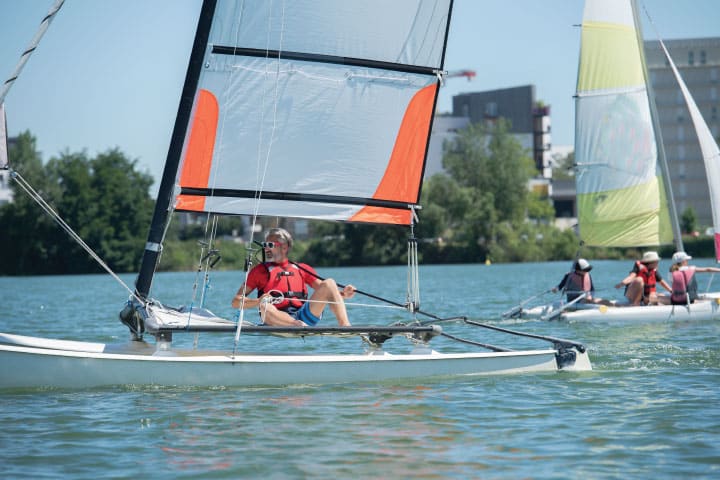
This rotomolded sailing catamaran is virtually indestructible, which is why it’s so popular with resort and hotel fleets. There are a few to choose from, with the 18-foot Mirage Tandem Island model offering not only sails but also patented pedal power below the water.
9. MiniCat (assorted lengths)
This model is surprisingly sophisticated, an inflatable sailing catamaran with kick-up rudders and lots of sail trim adjustments. It can be assembled in under an hour and packed into two bags for easy transport.
10. Catalina 22 (25 & 27 also available)
The smallest of the current Catalina Yachts line , the 22, and its slightly larger siblings can be sailed coastally and on lakes. These covered boats have a V- berth bunk, toilet, sink, ice box, and room for a camping stove.
Try renting a sailboat
You don’t need to own a sailboat to have the pleasure of cruising on one. You can rent a sailboat for a fun lake day. On Boatsetter, you’ll see many of the models we cover above. You have the pick of the litter to see which one fits your style of sailing. And if you ever buy a sailboat, you can list here and start making money renting it out!
Dive In! Here’s more on sailboats:
- 7 Best Sailboat Accessories
- 10 Best Beginner Sailboats
- Newport, Rhode Island: The Sailing Capital of the World
Boatsetter is a unique boat-sharing platform that gives everyone— whether you own a boat or you’re just renting — the chance to experience life on the water. You can list a boat , book a boat , or make money as a captain .
List your boat & start earning an avg. of $20K yearly with Boatsetter

Zuzana Prochazka is an award-winning freelance journalist and photographer with regular contributions to more than a dozen sailing and powerboating magazines and online publications including Southern Boating, SEA, Latitudes & Attitudes and SAIL. She is SAIL magazines Charter Editor and the Executive Director of Boating Writers International. Zuzana serves as judge for SAIL’s Best Boats awards and for Europe’s Best of Boats in Berlin.
A USCG 100 Ton Master, Zuzana founded and manages a flotilla charter organization called Zescapes that takes guests adventure sailing at destinations worldwide.
Zuzana has lived in Europe, Africa and the United States and has traveled extensively in South America, the islands of the South Pacific and Mexico.
Browse by experience

Explore articles
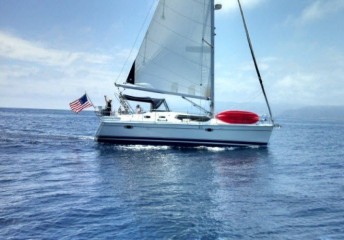
5 Reasons To Add Chesapeake Bay Boat Rentals To Your Boating Bucket List
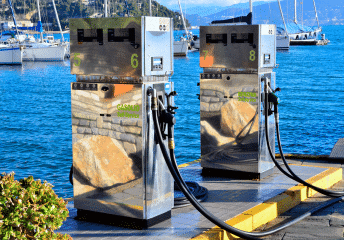
What Should You Do Before Fueling Your Boat? Boat Fueling Tips

Fishing in Seattle Guide: Salmon Fishing Tips
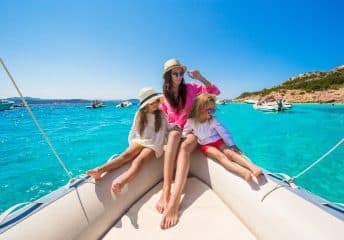
7 Great Boating Gifts Mom Will Love

How To Sail a Small Sailboat

Last Updated by
Jacob Collier
August 30, 2022
Sailing is a skill that takes time and practice to learn and perfect. Learning how to sail a small sailboat requires onshore and offshore activities.
Sailing heavily depends on the wind, and setting the sails right is a crucial sailing element. If you do not adjust the sails according to the wind, your boat will not move and, in worst cases, may even capsize.
Sailing is a skill that gets better with practice. There are several factors that you need to understand when sailing. These include the wind direction, how to turn and steer the boat, adjusting the sails, and finally, how to slow down and come to a stop.
Many novice sailors find handling the sailboat a daunting task. You have to take care of so many controls, including the tiller, the sails, and the centerboard.
Experienced sailors believe that new sailors should avoid taking their sailboats into open waters until they have gotten the hang of the water and the sailboat. Sailboats have tall sails, which make them prone to capsizing. Inexperienced sailors should either take courses on sailing or learn by going out with a friend before they head on their solo adventures.
Table of contents
How To Sail a Small Sailboat
Before heading out on your next boating adventure, you need to consider several factors. As the wind powers your boat, the first thing you need to understand is how wind strength and direction affect your boat. You will also need to learn how to handle the tiller. If you have been driving any road vehicle, you may not be surprised to see a vast difference between how a car and a boat handle.
Understanding Wind Direction
Wind plays a crucial role in how fast and the direction in which your sailboat will move. It is impossible to sail into a headwind. But you can sail around 45 degrees to headwind.
- When sailing 45 degrees to the oncoming wind, this is known in sailor jargon as the boat is close-hauled.
- When you are sailing with the wind coming from either side or almost 90 degrees to the boat, it is known for the boat to be on a beam reach.
- When you are sailing at a wide-angle in the direction of the wind. For instance, say that you need to head north, and the wind is coming from North East, the boat is called to be on a broad reach.
- If you are lucky and have the wind in the direction you are heading, your boat is known to be running.
Positioning Your Boat
It is crucial to be aware of the position of your sailboat in relation to the wind direction. This allows you to adjust the sails and balance the weight in your boat. For beginners, you can tie small wind vanes, which can be simple yarn strands on the boat to let you know where the wind is coming from.
What Affects Wind Direction
As you sail through the wind, your boat will also alter the wind direction. Since the boat has a giant sail, it creates its own wind as the boat moves forward. This wind is known as apparent wind. For instance, your boat is moving on a beam reach, where the true wind is coming from the side of the boat.
As you move through the wind, your boat makes its own apparent wind. The true and apparent winds combine, causing the wind direction to change. This can lead your boat to be on a close haul rather than on a beam reach. What matters, in the end, is how much resulting wind there is in your sails and the direction it is coming from.
Getting Ready To Sail
The best method to start sailing is to take the boat on from a point such as an anchor line or a mooring buoy. The wind will push the boat backward and out into the open waters as you get into the boat and set the sails up.
Moving stern first is acceptable when being pushed out of the marina, but this is not the direction in which we will want to continue sailing. You will have to turn the boat around so that wind is pushing the boat bow first.
Turning To Set Direction
As you come out of the marina, you will need to adjust your sails to change direction. Remember, boats require time to respond and need patience above all else.
The first step is to push the boom out of both sides of the boat. This will cause the wind to blow against the sail's back and not past its sides, causing the boat to rotate. As you pull in the sail and set its direction, the boat will begin to correct its course. Once you are in the right direction, you can tighten the mainsail and be well on your way.
Starting From A Beach Or A Dock
Starting from a beach or an enclosed dock can be quite challenging. If the wind pushes the boat sideways into the dock, it is next to impossible to sail out of the dock. In such a scenario, it would be best if you could walk your boat like a pet to the dock's end and attempt to turn it around to face the wind. You can then follow the procedure described above to allow the boat to come out of the marina.
Your boat will not move if the sails are not taut. As soon as you tighten the sails, the wind will move the boat, and you can then set the direction to your preference.
Steering The Boat
Now that you have set the direction and are moving in the correct direction, you will need to maintain direction and be able to steer the boat through the water. Before you begin to steer the sailboat, you must ensure that you are sitting in the direction opposite the sail. This is usually the direction from which the wind is blowing.
When the wind blows against the sails, it can cause your boat to tilt in their direction. Your body weight will counter the tilting effect and keep the boat level.
Using The Tiller
The sailboat is equipped with a rudder. As your boat picks up speed, you can use the rudder to steer the boat. A little tiller usually controls the rudder. The tiller takes some time to get used to. The reason for this is that it works in opposite directions. For instance, if you want to make the boat turn right (towards the starboard side), you will have to push the tiller to the left (towards the port side) and vice versa.
The rudder is hinged in line with the tiller. When you move the tiller in one direction, it moves the rudder. For instance, the rudder will extend towards the starboard side if you push the tiller to the port side. The water flowing will push against the rudder, and the resistance from the rudder will rotate the boat towards the starboard side .
The tiller can be tricky to use. Ensure that you make minor adjustments to the tiller until you get used to how it moves your boat.
Handling The Sails
There is one rule that you must remember when positioning your sails. If you are sailing towards the wind, you will have to pull in the sails more. Similarly, if you are on a broad reach and sailing in the direction of the wind, you will have to extend the sails more.
When the sails are extended and you are on a broad reach, you will notice that the boat tilts to the side the sails are on. You must seat yourself so that you counter the tilting effect.
Sail Trimming
No, you don't need a pair of scissors for this. A sail comprises multiple sheets, and adjusting these sheets is known as trimming the sail. Your goal with trimming the sail is to give the sail the best possible shape to make maximum use of the wind.
Mainsail Trimming
When trimming the mainsail, you will have to make sure that it is tight enough so that the sail's leading edge is not flapping or shaking. At the same time, you have to ensure that it is not too tight, causing the wind to blow against only one side of the sail. This can cause the boat to tilt to one side.
Leaving the edge loose means you will lose efficiency. The wind energy will be used to flap the sail instead of pushing your boat forward. This unwarranted movement of the sail is known as luffing, which can significantly reduce the boat's efficiency.
Adjusting The Mainsheet
One method to trim the mainsail is to let the mainsheet out until the mainsail starts to luff. Then slowly pull in the sheet, and stop as soon as the sail stops luffing.
If the sail is too tight, you will be able to judge by its appearance. The sail will have no slack and will look perfect. The only way to correct the tightness is to loosen it until it starts to luff, then tighten it gradually, and stop as soon as the luff is gone.
Trimming The Jib
Adjusting the jib also follows the same procedure as the sail. The goal is to loosen the sail until it starts to luff and then tighten it back up until there is no luffing. Like the mainsail, the appearance of the job will have a lot to say about its tightness.
Some sailboats have streamers on the leading edge of the jib, which depict airflow direction over it. When the sail is in the correct trim setting, the streamers will blow straight and on both sides around the sail.
Another factor to consider when adjusting the jib is the space between the mainsail and the jib. The gap, known as the slot, has to be the same from front and back. This ensures that wind flows smoothly between the sails, making the setup efficient. If either is too tight or loose, the slot will obstruct the wind flow, causing turbulence and slowing the boat down.
Turning The Boat
The most crucial part of sailing is always being aware of the wind direction. This becomes even more important when you are planning to turn the boat. If you are careless while making the turn and accidentally turn the wrong way, you may capsize the boat .
There are three common types of turns that you can make with sailboats.
Sailing Close Hauled
If the wind is coming at you head-on from either side, and you are close hauled, check for the direction of the wind. If it is blowing from the starboard side, turn the boat towards the right so that you point your bow into the wind. Continue turning until the wind is now coming to your port side. This technique is called tacking, which involves turning into the wind.
Sailing Broad Reach
If the wind is coming from either side or slightly behind you, you can turn so that the stern of your boat becomes head-on with the wind. For instance, if the wind is coming from the starboard side, you will turn left to make sure the wind hits the stern. This technique is known as jibing, and it allows you to make the turn downwind.
No Wind Crossing
This technique can be used if you want to make small turns. Say you are sailing close-hauled with wind flowing from your port side. You turn left, and now the wind is approaching from the side, and you begin to sail broad reach. The wind remains on your starboard side, but the direction has changed.
How To Position The Sails
For the initial two types of turns, where you will be crossing the wind with your stern or bow, the sails will have to be crossed over to the opposing side. You will also need to change your seating location to make sure you sit opposite the sails.
Since crossing the wind requires a lot of work, most sailors prefer to turn without crossing the wind. All you need to do is make small trimmings to the sail to keep you going in the right direction for this type of turn. With experience, you will be able to adjust the sails during your turn.
Remember, the closer the wind direction is to your bow, the more you will need to pull in the sails. The closer the wind direction is to your stern, the more you want your sails to be open. While turning, it would be best to keep one hand on the mainsail if you need to adjust its direction to prevent your boat from being blown in random directions.
The Centerboard
You will notice a thin and long blade of metal or fiberglass hanging from the boat's center and into the water. This component is called the centerboard, and it helps resist the sideways movement of the boat. You can raise or lower the centerboard at your discretion.
When you are sailing, the wind comes from either the left or right of the boat. If the wind is strong enough, it can push the boat to one side. Lowering the centerboard will cause it to act as a keel and prevent the boat from veering off in the wind direction.
When you are sailing along with the wind, you will have the wind coming from the rear of the boat, and it will have little influence from either side. In such a scenario, you will not need the centerboard. Raising the centerboard will reduce the drag, allowing you to sail faster.
As a beginner, it is recommended to keep the centerboard down. Who knows when it may save you? You don't have to be too concerned about it, as you have more important things such as the sail to worry about.
Slowing Down and Stopping
When it comes to sailing, speed is thrilling. Going fast is fun, but in a sailboat, speed is an achievement. The only thing more important than going fast is knowing how to slow down, such as when coming to a stop or avoiding an obstacle along the way.
Theoretically, to slow down, you have to do the opposite of what you would do if you wanted to speed up. This means that you will want to ensure that any wind that falls on your sails gets wasted or "spilled."
The best way to do this is to let out and loosen the sails until they begin to luff. If you need to slow down faster, you can loosen them further until they start to flap. If you plan to come to a stop, you can let the sails flap continuously.
However, if you are heading downwind or running, the mainsail should not be pushed out. Instead, you can pull it in as much as possible so the sail will not collect any wind. With no wind in the sails, your boat will slow down.
The simplest way to stop the boat is to turn it towards the wind. This will ensure maximum resistance and bring the boat to a halt.
Related Articles
What Are Small Sailboats Called?
10 Best Small Sailboats (Under 20 Feet)
Are Small Sailboats or Big Sailboats Faster?
Born into a family of sailing enthusiasts, words like “ballast” and “jibing” were often a part of dinner conversations. These days Jacob sails a Hallberg-Rassy 44, having covered almost 6000 NM. While he’s made several voyages, his favorite one is the trip from California to Hawaii as it was his first fully independent voyage.
by this author
How to Sail
Most Recent

What Does "Sailing By The Lee" Mean?
Daniel Wade
October 3, 2023

The Best Sailing Schools And Programs: Reviews & Ratings
September 26, 2023
Important Legal Info
Lifeofsailing.com is a participant in the Amazon Services LLC Associates Program, an affiliate advertising program designed to provide a means for sites to earn advertising fees by advertising and linking to Amazon. This site also participates in other affiliate programs and is compensated for referring traffic and business to these companies.
Similar Posts

How To Choose The Right Sailing Instructor
August 16, 2023

How To Sail From California To Tahiti
July 4, 2023

How To Tow A Skier Behind A Boat
May 24, 2023
Popular Posts

Best Liveaboard Catamaran Sailboats
December 28, 2023

Can a Novice Sail Around the World?
Elizabeth O'Malley
June 15, 2022

4 Best Electric Outboard Motors

How Long Did It Take The Vikings To Sail To England?

10 Best Sailboat Brands (And Why)
December 20, 2023

7 Best Places To Liveaboard A Sailboat
Get the best sailing content.
Top Rated Posts
Lifeofsailing.com is a participant in the Amazon Services LLC Associates Program, an affiliate advertising program designed to provide a means for sites to earn advertising fees by advertising and linking to Amazon. This site also participates in other affiliate programs and is compensated for referring traffic and business to these companies. (866) 342-SAIL
© 2024 Life of Sailing Email: [email protected] Address: 11816 Inwood Rd #3024 Dallas, TX 75244 Disclaimer Privacy Policy
- International edition
- Australia edition
- Europe edition
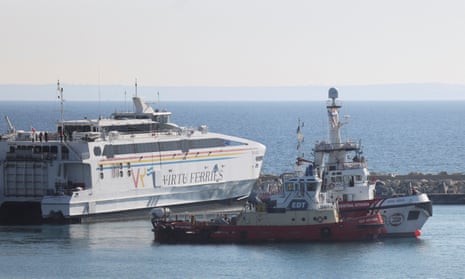
First aid ship to Gaza leaves Cyprus port in pilot project
Charity ship seen sailing out of Larnaca towing barge containing 200 tonnes of flour, rice and protein
An aid ship that has been docked in Cyprus for close to a month has finally set sail for Gaza, taking almost 200 tonnes of aid in a pilot project to open a new sea route for aid to a population on the brink of famine.
A video showed the Open Arms boat departing the Mediterranean island’s southern port of Larnaca at an unknown time early on Tuesday. Government officials in Cyprus had said the exact timing of the vessel’s departure would not be released for security reasons.
However, maritime tracking sites showed the Open Arms in the eastern Mediterranean, slowly heading for Gaza. The boat is towing a barge containing flour, rice and protein as well as water and medicines – provisions that are desperately needed in the besieged coastal strip.
While the journey usually takes about 15 hours, the aid boat and its accompanying barge were travelling at about 3.7 knots, making a timeframe for the voyage of up to two days more likely.
The mission, mostly funded by the United Arab Emirates, is being organised by the US-based charity World Central Kitchen (WCK), while the Spanish charity Proactiva Open Arms is supplying the ship.
WCK’s founder, José Andrés, and its chief executive, Erin Gore, said: “Our goal is to establish a maritime highway of boats and barges stocked with millions of meals continuously headed towards Gaza .”
According to WCK and statements in the Israeli media on Tuesday, the Open Arms will dock at a jetty at a beach site in northern Gaza, which is being built by the charity.
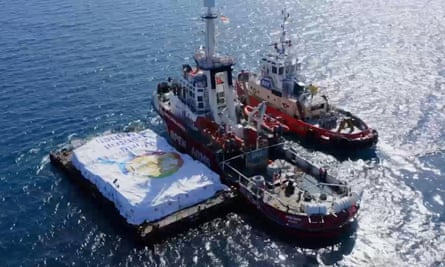
WCK said it was creating the landing jetty with material from destroyed buildings and rubble. It had a further 500 tonnes of aid amassed in Cyprus, which would also be dispatched, it said.
According to Israel’s Kan radio network, work has been under way by WCK and other aid agencies – with the permission of the Israeli military – in recent days to flatten the shore with machinery and construct the platform, which would allow the aid to be unloaded and transported by truck within Gaza.
The ship set sail as the president of the European Commission, which is backing the new aid route, warned that starvation in Gaza was not acceptable. The Ursula von der Leyen in a speech to the European parliament on Tuesday, said: “The situation on the ground is more dramatic than ever, and it has reached a tipping point. We have all seen the reports of children dying of starvation. This cannot be.”
Insiders in the EU say the sailing was always going to be difficult because of Israel’s security concerns and wider issues about how the aid will be distributed.
The EU is also supporting airdrops of aid but insiders say the land corridor through Rafah is still the most important. Before the war, about 500 tonnes of aid were being sent by the EU to Gaza but this has been reduced to 100 tonnes a day since October.
Von der Leyen also announced the EU was standing up a “civil protection mechanism” usedin responses to emergencies and natural disasters.
It is understood the mechanism has been triggered by the UN and the World Food Programme but will give rise to a round-the-clock emergency response centre that operates under the auspices of the European Commission.
The centre can now issue notification to member states for specific aid required, likely to be parachutes and containers, and coordinate offers of equipment with the right to reimburse member states up to 75% of the cost of transport to Cyprus.
The inaugural voyage is considered a pilot mission. Open Arms had originally been expected to leave Larnaca on Friday, then on Sunday and then Monday. The missed deadlines were attributed to “technical reasons”. Late on Monday, Greek Cypriot media reported that delays in constructing the landing jetty for the aid were responsible.
Gaza has been sealed off from the outside world since Israel began its offensive in response to an attack on Israel by Hamas militants on 7 October.
The sailing is a separate initiative from that announced last week by the US, which plans to build a temporary pier to facilitate aid deliveries by sea. Tuesday’s mission, if successful, would in effect signal the first easing of an Israeli naval blockade imposed on Gaza in 2008 after Hamas took control of the Palestinian territory.
With the humanitarian crisis in Gaza becoming increasingly desperate, international players have been scrambling to find alternative routes to supply aid.
Cyprus said its maritime corridor offered a fast-track workaround to getting aid delivered. Cargoes are to undergo security inspections in Cyprus by a team including personnel from Israel, eliminating the need for screenings at the final offloading point to remove potential delays.
- Israel-Gaza war
- Palestinian territories
- Middle East and north Africa
- Humanitarian response

Netanyahu ‘determined’ to carry out Rafah assault despite pleas from Biden

Canada to halt arms sales to Israel after non-binding vote in house of commons

UN says Israeli restrictions on Gaza food aid may constitute a war crime

The Guardian view on famine in Gaza: a human-made catastrophe

Documents reveal alleged pattern of Israeli harassment of Unrwa workers on West Bank

Israeli delegation to visit Washington to discuss planned offensive on Rafah

Jared Kushner says Gaza’s ‘waterfront property could be very valuable’

Fierce clashes between IDF and Hamas after Israel takes control of key hospital

‘Catastrophic levels of hunger’ in Gaza mean famine is imminent, says aid coalition
Most viewed.

IMAGES
VIDEO
COMMENTS
Catalina 16.5. jlodrummer. Catalina Yachts are synonymous with bigger boats but they have some great and smaller boats too such as Catalina 16.5. This is one of the best small sailboats that are ideal for family outings given that it has a big and roomy cockpit, as well as a large storage locker.
The boat is designed with positive flotation and offers good load-carrying capacity, which you could put to use if you added the available canvas work and camping tent. NorseBoats offers a smaller sibling, the 12.5, as well; both are available in kit form. $19,000, (902) 659-2790, norseboat.com.
Vancouver 28. Photo credit: YachtFathom.co.uk. A sensible small boat with a "go-anywhere" attitude, this pocket cruiser was designed with ocean sailors in mind. One of the best cruising sailboats under 40 feet, the Vancouver 28 is great sailing in a small package. Hull Type:Full keel with transom hung rudder.
Balboa 26. Balboa 26 Courtesy Of Matts G. Djos. First splashed in 1969, the Balboa 26 continues to enjoy a strong following among budget-minded cruisers. Built sturdy and heavy, all of the boat's stress points are reinforced. The spacious cockpit comfortably seats 4 and is self bailing, ensuring that sailors stay dry.
Twenty Small Sailboats to Take You Anywhere. John Vigor turns the spotlight on twenty seaworthy sailboats that are at home on the ocean in all weather. These are old fiberglass boats, mostly of traditional design and strong construction. All are small, from 20 feet to 32 feet overall, but all have crossed oceans, and all are cheap.
Hunter 22. Hunter 22 is a clever boat for a very fair price. It retains the hull of its predecessor- Hunter 216, featuring an open transom and a large cockpit. However, it is made of fiberglass with balsa-cored topsides and a solid bottom section. Furthermore, the deck is a bit changed, having a 40 sq. ft. larger rig.
The best budget small cruiser sailboats include the Catalina 22 for its versatility, Hunter 27 for durability, Beneteau First 20 for performance, West Wight Potter 19 for compactness, Compac Sun Cat for ease of use, MacGregor 26 for adaptability, and Jeanneau Sun Odyssey 349 for comfort and style. As a seasoned sailor with years of navigating ...
Catalina 16.5. The Catalina 16.5 sits right in the middle of Catalina Yachts' line of small sailboats, which range from the 12.5 to the 22 Capri and Sport, and it comes in both an easy-to-trailer centerboard model and a shoal-draft fixed-keel configuration. www.catalinayachts.com. With the fiberglass board up, the 17-foot-2-inch boat draws ...
The Best Sailboats Under 25 Feet. Pocket cruiser: Cornish Crabber 24. British manufacturer Cornish Crabber has been producing beautiful, traditional style small sailboats for decades, ensuring they honor their heritage both in the construction style and appearance of their boats. The Cornish Crabber 24 is the most iconic of their range and ...
Small sailboats are generally under 20 feet in length, come in a variety of designs, and have different hulls. These include monohulls, catamarans, and trimarans. ... What I love about it is that just about all of the 20 feet of the boat is an open cockpit. If I were consistently using it in rougher waters, I would recommend adding a spray hood ...
Discover everything about small sailboats—from dinghies to ocean cruisers. Our in-depth guide covers types, features, and FAQs for beginners to experts. +49 211 54 69 22 23 ... but not all small boats are designed for the open sea. Bluewater sailboats and specific ocean cruisers are designed to handle more challenging conditions and are ...
The Pardeys are icons of small sailboat cruising. Having sailed over 200,000 nautical miles and circumnavigated both east and westbound on their home-built, engine-free, sub-30-feet cutters, they are among the most recognized sailors in the world. They're also known as "America's first couple of cruising.".
West Wight Potter 15. The West Wight Potter 15 is one of the best small trailerable and seaworthy 15-foot sailboats of all time. It's easy to handle and great for both coastal and offshore cruising. She has an aluminum mast and tiller, a small cabin that comfortably sleeps a couple and also we can't miss referring to her elegant design.
Small Sloops. Small sloops with a mast that carries head and mainsails are the next step so students learn how sails work together. Headsails can be hanked on or attached to a small roller furler. These boats may have some or no winches, which also makes them easier to maintain. These boats can usually be sailed with one to four people.
Montgomery 17 - This small sloop has a length of roughly 17 feet and a retractable centerboard keel that can make the boat draft just 2 feet. Super Snark - The Super Snark is 11 feet long and weighs just 50 pounds with a payload capacity of about 310 pounds. Flying Scot - At just under 20 feet in length, the Flying Scot is one of the larger ...
Choosing the best small sailboat under 20 feet when you are getting ready to sail ultimately depends on your preferences and sailing goals. The Hunter 17 offers a spacious cockpit and stability, making it an excellent choice for families and beginners. On the other hand, the O'Day Javelin focuses on simplicity and affordability, making it an ...
In this episode, we're sharing my top list of some of the most affordable small sailboats or daysailers under US$ 100,000, and we'll talk about their price a...
Discover sailboat rentals for a lake day near you. 1. Optimist. The Optimist sailing dinghy weighs under 80 pounds and is virtually unsinkable. They're easy to find since over 100,000 hulls have been sold. 2. Laser. Designed in the 1970s, the Laser is a simple sailboat with a single sail and room for one.
Another day, another adventure for this thin-water sailor. Beach-cruising or sailing-camping boats come in all shapes and styles, ranging from one-design sail trainers like the Flying Scot, Hobie 16 and Wayfarer 16 to more cruising-oriented craft, like the Hobie Mirage trimaran series, the NorseBoat line or the UK-built Cornish Shrimperseries.
A dinghy is a type of small open sailboat, more akin to a day sailer. Characterized for their short length overall and light weight, which also makes them very easy to handle, sailing dinghies are used for recreation, youth sailing programs, sail training, and tending a larger vessel. Ketch. A ketch is a type of sailing yacht with two masts.
The term small boat is open to interpretation. After all, when standing on the deck of your 200-foot megayacht, your 40-foot quad-outboard center console tender is the "small boat." When strolling past the quay in Monaco, the only small boats in sight are the kayaks from the resort.
Answers for small open boat crossword clue, 6 letters. Search for crossword clues found in the Daily Celebrity, NY Times, Daily Mirror, Telegraph and major publications. Find clues for small open boat or most any crossword answer or clues for crossword answers.
Sailing Close Hauled. If the wind is coming at you head-on from either side, and you are close hauled, check for the direction of the wind. If it is blowing from the starboard side, turn the boat towards the right so that you point your bow into the wind. Continue turning until the wind is now coming to your port side.
An aid ship that has been docked in Cyprus for close to a month has finally set sail for Gaza, taking almost 200 tonnes of aid in a pilot project to open a new sea route for aid to a population on ...